#i love all the new comedians we are seeing. from elsewhere in the world not just dropout
Explore tagged Tumblr posts
Text
do you think they haven't had lou on an episode of vip because they're scared. do you think that's what it is. because they fear what he may create.
#lou on an episode of vip yesterday!!!#i love all the new comedians we are seeing. from elsewhere in the world not just dropout#but you're telling me lou is too busy to get on there?? you're telling me no ally season 2 character??? why#vip#dropout#a lou and brennan episode would explode my brain. goop everywhere. and i'd die happy#mine
8 notes
·
View notes
Text
The Trial of the Chicago 7 (Or, Sorkin’s attempt to show you how nothing has changed in 52 years)
If you know anything about Aaron Sorkin, the much-acclaimed writer/creator of television shows like The West Wing, The Newsroom, you know that subtlety is not his strong suit. So, I was rather hesitant going into his newest film, The Trial of the Chicago 7, the infamous trial of eight gentlemen accused of conspiracy to incite violence/rioting in Chicago during the notorious 1968 DNC riots. Without diving too deep into the history, August 1968 was not Chicago’s finest hour. When the protesters chanted as a warning to the police, “The Whole World Is Watching!”, they weren’t wrong. Years ahead of the 24-hour news cycle, people all across America (and across the world) were glued to the TV watching the Chicago police beat the ever-living snot out of young folks protesting the Democratic Party’s decision to support the ever-controversial war in Vietnam. The film’s subject matter is sure to draw parallels to and resonate strongly with both the protests and civil unrest that took place this past summer following the death of George Floyd and countless other Black folk at the hands of police. So despite it’s appropriate timeliness, I was hesitant to watch this movie because I really wasn’t interested in watching Aaron Sorkin (who not only wrote but directed this film) try to mansplain to me that the trial of the Chicago 7 was all about injustice! Without knowing anything else about the trial beforehand (and I really didn’t), I already knew it’s a famous case of injustice. I wanted to watch the movie to learn about the people, the humans involved, and the nuance of the situation.
The film gets off to a rough start in the nuance department. After an effective montage introducing us to six of the eight members of the Chicago 7 (we’ll get to why there’s that numerical discrepancy), we meet the character who will be the lead prosecutor of the case: a straight-laced, clean-cut lawyer played by Joseph Gordon-Levitt. In an attempt to plant the seed early on that the eponymous trial is a sham, the first real scene of the film sees Gordon-Levitt meeting with Nixon’s newly appointment Attorney General John Mitchell who is pissed off that the prior AG didn’t resign from the office until an hour before Mitchell was confirmed. As retaliation, and in line with history’s understanding of Nixon’s pathologic paranoia, Mitchell decides to re-open the case exploring whether there was any conspiracy to incite riots in Chicago 1968. As JGL explains, this was something which Johnson’s AG as well as prior FBI investigations already decided did was not a viable case. The conversation that ensues is a little too on-the-nose. JGL shares his concerns that he doesn’t believe that the Chicago 7 are actually guilty, but Mitchell tells JGL, “then imagine how impressed I’ll be when you get a conviction.”
Of course, this conversation is largely a Sorkin invention, as is the weird decision to try to humanize the prosecutor played by Gordon-Levitt. I say "weird" because the film doesn’t do anything with it. We don’t get a real sense beyond that initial scene that JGL feels guilt or remorse for being a cog in the Nixon machine. The beginning of the film sets him up to be a similar character to David Schwimmer’s fascinating turn as Robert Kardashian in The People vs. O.J. Simpson. But in the end, it’s clear that Sorkin uses him just as a way in the beginning of the film to provide the thesis statement for the film, as if he were writing this script as a college term paper. This bothers me so much because it makes a late-film surprise appearance by Michael Keaton as Johnson’s AG lose a good deal of its impact. It would have been so much better if we as the audience came to the same revelation about the political origin of the trial at the same time that the defense lawyers did.
Sorkin’s lack of subtlety reared its ugly head in a few key moments that caused me to audibly groan while watching this film. Towards the end of the film, one of the more dramatic defendants, the merry prankster hippie Abbie Hoffman (played very well by Sacha Baron Cohen), is on the stand and is asked a particularly difficult question by the prosecution. He pauses. The prosecution asks what’s taking so long. Hoffman responds in a serious tone that runs opposite of his usual character, “Sorry, I’ve never been on trial for my thoughts before.” The film then slowly fades to black. I half-expected to hear the famous Law & Order “chun-chunn” sound next. That’s how cheesy and self-righteous the scene was.
The film’s ending too, where the defendants read off a list of all the fallen soldiers from Vietnam prior to their sentencing, felt a little too Hollywood to be believable… and indeed it didn’t happen that way. Elsewhere in the film, one of the more “prim and proper” defendants, the young head of the Students for a Democratic Society Thomas Hayden played by Eddie Redmayne, reflexively stands in honor of the judge’s exit as is court custom, forgetting that he and the rest of the defendants agreed not to stand. That’s not the bad part. The bad part comes later when Redmayne’s character travels to someone’s home and the Black maid who answers the door says to him, “I heard you were the only one to stand for the judge,” and then the camera just sorta lingers on her disappointment. We get it! The judge is a bad dude! Let’s move on!
Seriously, let’s move on. For all my griping, this is a very good movie. Those instances where Sorkin’s moral heavy-handedness is plain to see are so glaring because for the most part, the movie does a fantastic job of addressing the film’s (sadly still) politically controversial themes (police brutality, the culpability of protesters in starting riots, systemic racism, etc.) with a good deal of nuance. This mostly happens when Sorkin just sticks to the facts of the case, like when dealing with the whole saga of Bobby Seale, the eighth and only Black man of the Chicago 7. The day before the trial begins, Seale's lawyer required emergent surgery. Seale’s motion to have the trial postponed till he receive proper counsel is denied, as is his request to represent himself. Therefore, on trial without counsel, he frequently interrupts the court arguing about the unconstitutional nature of his trial, until the judge, played to chilling perfection by Frank Langella, becomes fed up with the interruptions and orders that Seale be bound, gagged, and chained to his chair. It’s a crazy powerful and uncomfortable scene, among the most haunting images I’ve seen in cinema. Finally, Seale’s case is determined to be a mistrial, changing the number of defendants from eight to seven. Hence, the Chicago 7.
But, the most inspired sequence of the film comes late in the movie when the defense gets wind of the prosecution’s plan to play a recording from the night of the riots where the prim and proper Tom Hayden can be (arguably) heard urging hundreds of listeners to “let blood flow all over the city.” Tom still believes that he would do well on the witness stand, but his defense lawyer (Mark Rylance as William Kuntsler) insists on showing him why this would be a bad idea. The ensuing scene sees Rylance role play the part of the prosecution cross-examining Hayden while the film intercuts scenes of a flashback of the actual events. the ���truth” of that night, significantly muddies the water for this case. It by no means proves that the Chicago 7 are guilty of a conspiracy, but it certainly highlights the more human aspect of their situation. How is one expected to keep their calm when their best friend is beaten? And to what degree are people to be held responsible for decisions made in the heat of the moment?
The movie also has also interesting commentary on who should be the “face” or progressive politics, even today: the well-to-do and respectable Hayden or the in-your-face hippie comedian Hoffman? It’s an interesting question that never seems fully explored or resolved. Sorkin seems to land in the camp that Hayden’s respectability merely maintains status quo whereas Hoffman’s flagrant anti-establishment views is required for real change. But I don’t know how much of that is me just loving Cohen’s performance as Hoffman and finding Redmayne’s Hayden to be (appropriately) insufferably pretentious. Sorkin certainly gives Cohen the better lines.
Overall, this is a movie held up by its two primary strengths: its cast and its film structure. Aside from general inconsistencies of the script’s tone and the notable weakness I mentioned previously about overplaying the political motivation for the trial in the film's first 5 minutes, the film is nearly perfectly structured. We are sort of dropped in medias res into the trial and only get the facts of those few days shown to us in carefully placed flashbacks that help to flesh out the drama of the trial. It helps maintain pacing in what could have been a drag of a legal drama.
But really, it’s the cast and their performances that sell this movie. Sacha Baron Cohen is the star in my mind, so perfectly cast as Abbie Hoffman, but Frank Langella as the septuagenarian, prejudiced judge of the case is equally powerful. Yahya Abdul-Manteen II as the Black Panther Bobby Seale lends an air of desperate seriousness to the film, Eddie Redmayne shines as that white liberal dude who takes himself way too seriously, and Mark Rylance is wonderful as the courageous lead defense attorney, particularly in scenes dealing with Bobby Seale. While the whole trial weighs on him heavily as the film progresses, his genuine concern for Seale is palpable.
I spent much of this review telling you the things that were odd about this film, and I stand by that. But as I said, those things stand out because this is such a slick production that the cracks become that much more obvious. It largely avoids Sorkin’s penchant for blunt lack of nuance and offers a story that helps to greatly contextualize the very world we live in. It’s interesting that a story that sees ten men (including their lawyers) fail to win a fight against The Man still feels like an inspiring underdog tale. It resonated well with this viewer, especially as the ending makes clear that justice is eventually served. Yet, I recognize this may be a dangerous tale to tell these days, and why I think the movie is so successful is that it gives plenty of sobering evidence to suggest that justice (both then and now) is by no means guaranteed.
***/ (Three and a half out of four stars)
58 notes
·
View notes
Text
TV I Liked in 2020
Every year I reflect on the pop culture I enjoyed and put it in some sort of order.
Was there ever a year more unpredictably tailor-made for peak TV than 2020? Lockdowns/quarantines/stay-at-home orders meant a lot more time at home and the occasion to check out new and old favorites. (I recognize that if you’re lucky enough to have kids or roommates or a S.O., your amount of actual downtime may have been wildly different). While the pandemic resulted in production delays and truncated seasons for many shows, the continued streaming-era trends of limited series and 8-13 episode seasons mean that a lot of great and satisfying storytelling still made its way to the screen. As always, I in no way lay any claims to “best-ness” or completeness – this is just a list of the shows that brought me the most joy and escapism in a tough year and therefore might be worth putting on your radar.
10 Favorites
10. The Right Stuff: Season 1 (Disney+)

As a space program enthusiast, even I had to wonder, does the world really need another retelling of NASA’s early days? Especially since Tom Wolfe’s book has already been adapted as the riveting and iconoclastic Philip Kaufman film of the same name? While some may disagree, I find that this Disney+ series does justify its existence by focusing more on the relationships of the astronauts and their personal lives than the technical science (which may be partially attributable to budget limitations?). The series is kind of like Mad Men but with NASA instead of advertising (and real people, of course), so if that sounds intriguing, I encourage you to give it a whirl.
9. Fargo: Season 4 (FX)
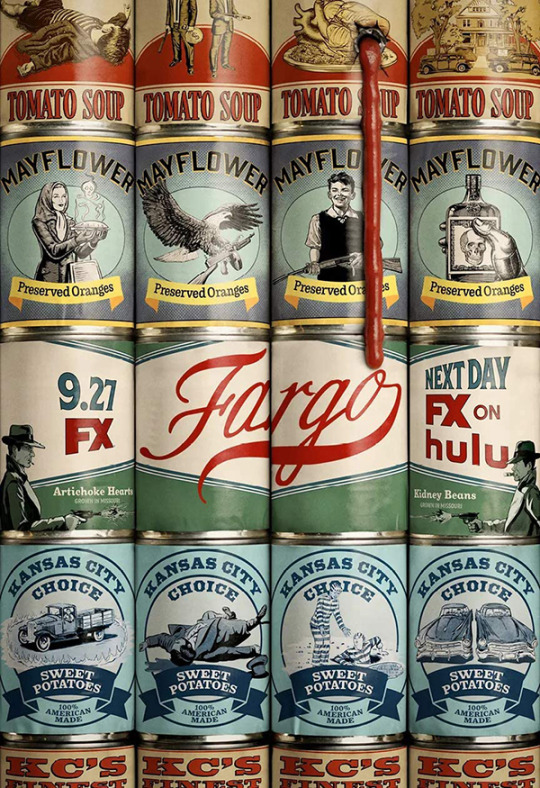
As a big fan of Noah Hawley’s Coen Brothers pastiche/crime anthology series, I was somewhat let down by this latest season. Drawing its influence primarily from the likes of gangster drama Miller’s Crossing – one of the Coens’ least comedic/idiosyncratic efforts – this season is more straightforward than its predecessors and includes a lot of characters and plot-threads that never quite cohere. That said, it is still amongst the year’s most ambitious television with another stacked cast, and the (more-or-less) standalone episode “East/West” is enough to make the season worthwhile.
8. The Last Dance (ESPN)

Ostensibly a 10-episode documentary about the 1990s Chicago Bulls’ sixth and final NBA Championship run, The Last Dance actually broadens that scope to survey the entire history of Michael Jordan and coach Phil Jackson’s careers with the team. Cleverly structured with twin narratives that chart that final season as well as an earlier timeframe, each episode also shifts the spotlight to a different person, which provides focus and variety throughout the series. And frankly, it’s also just an incredible ride to relive the Jordan era and bask in his immeasurable talent and charisma – while also getting a snapshot of his outsized ego and vices (though he had sign-off on everything, so it’s not exactly a warts-and-all telling).
7. The Queen’s Gambit (Netflix)
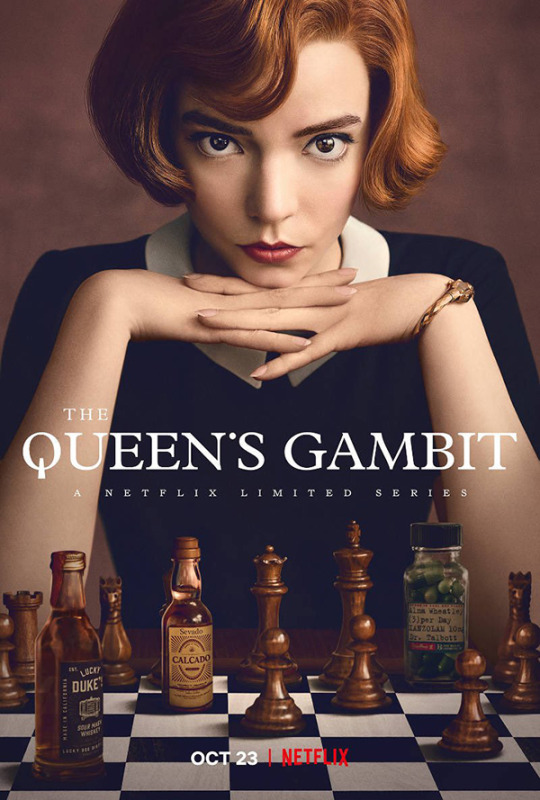
This miniseries adaptation of the Walter Tevis coming-of-age novel about a chess prodigy and her various addictions is compulsively watchable and avoids the bloat of many other streaming series (both in running time and number of episodes). The 1960s production design is stunning and the performances, including Anya Taylor-Joy in the lead role, are convincing and compelling.
6. The Great: Season 1 (hulu)
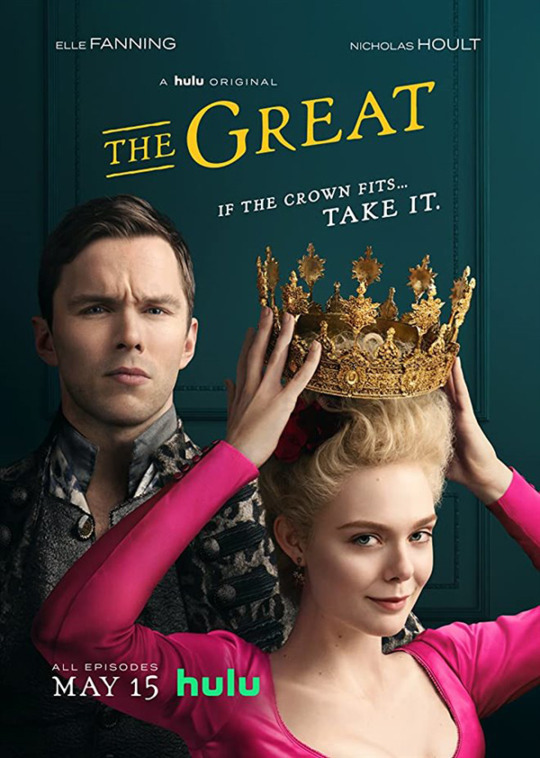
Much like his screenplay for The Favourite, Tony McNamara’s series about Catherine the Great rewrites history with a thoroughly modern and irreverent sensibility (see also: Sofia Coppola’s Marie Antoinette). Elle Fanning brings a winning charm and strength to the title role and Nicholas Hoult is riotously entertaining as her absurdly clueless and ribald husband, Emperor Peter III. Its 10-episodes occasionally tilt into repetitiveness, but when the ride is this fun, why complain? Huzzah!
5. Dispatches From Elsewhere (AMC)
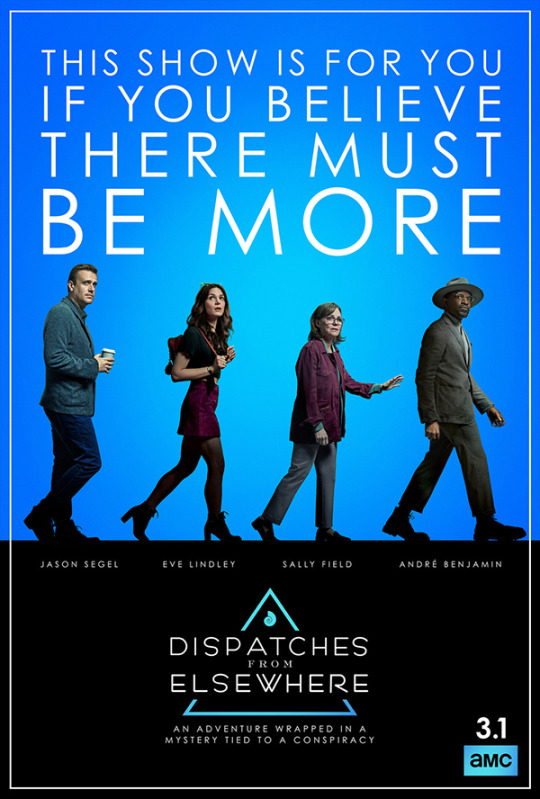
A limited (but possibly anthology-to-be?) series from creator/writer/director/actor Jason Segal, Dispatches From Elsewhere is a beautiful and creative affirmation of life and celebration of humanity. The first 9 episodes form a fulfilling and complete arc, while the tenth branches into fourth wall-breaking meta territory, which may be a bridge too far for some (but is certainly ambitious if nothing else). Either way, it’s a movingly realized portrait of honesty, vulnerability and empathy, and I highly recommend visiting whenever it inevitably makes its way to Netflix, or elsewhere…
4. What We Do in the Shadows: Season 2 (FX)
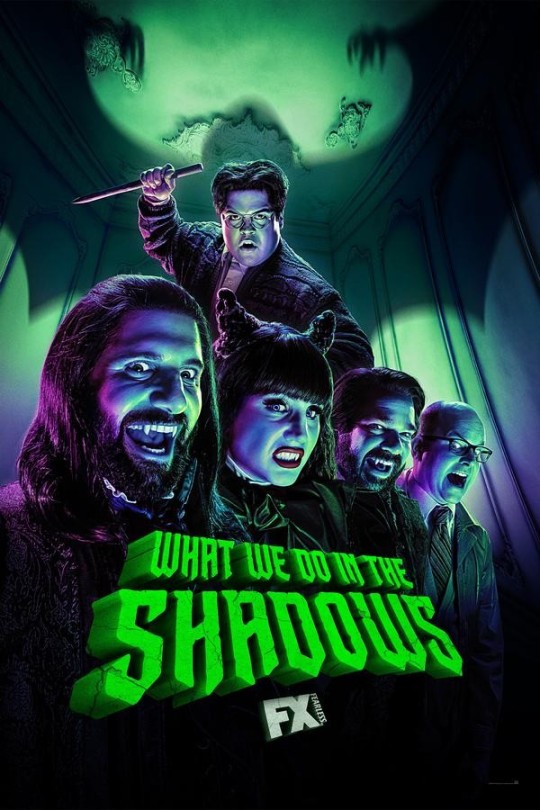
The second season of WWDITS is more self-assured and expansive than the first, extending a premise I loved from its antecedent film – but was skeptical could be sustained – to new and reinvigorated (after)life. Each episode packs plenty of laughs, but for my money, there is no better encapsulation of the series’ potential and Matt Berry’s comic genius than “On The Run,” which guest-stars Mark Hamill and features Laszlo’s alter ego Jackie Daytona, regular human bartender.
3. Ted Lasso: Season 1 (AppleTV+)
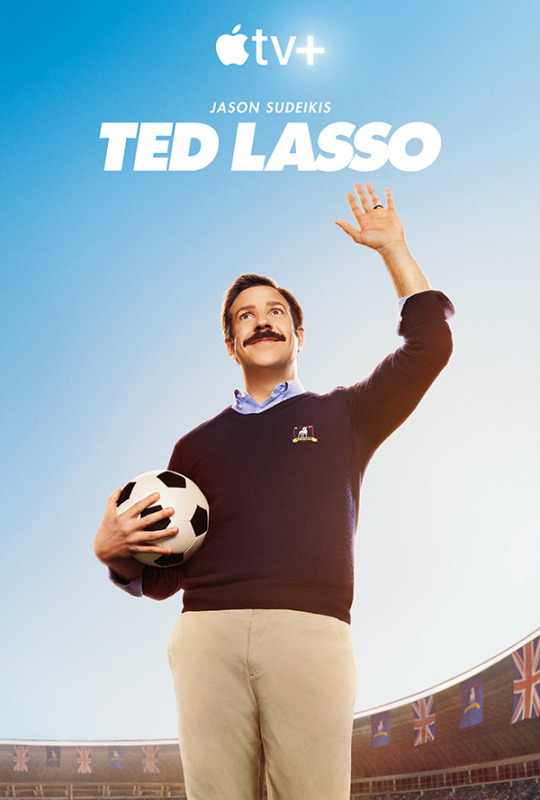
Much more than your average fish-out-of-water comedy, Jason Sudeikis’ Ted Lasso is a brilliant tribute to humaneness, decency, emotional intelligence and good coaching – not just on the field. The fact that its backdrop is English Premier League Soccer is just gravy (even if that’s not necessarily represented 100% proficiently). A true surprise and gem of the year.
2. Mrs. America (hulu)
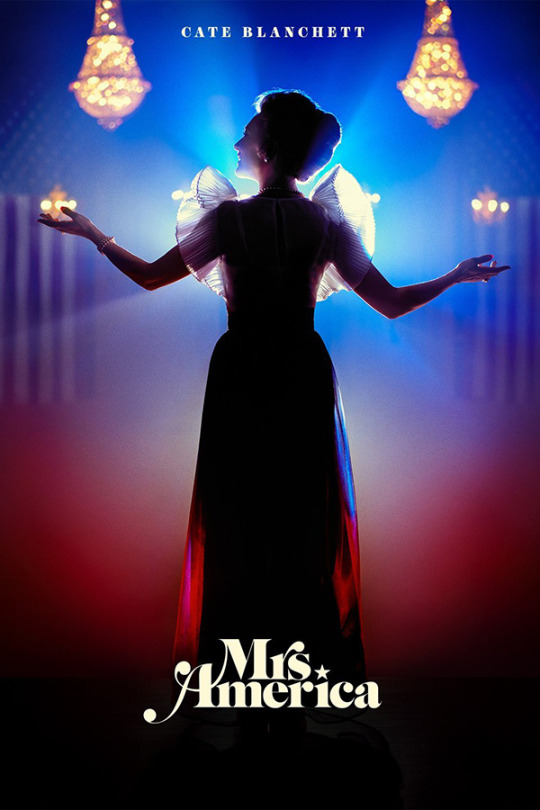
This FX miniseries explores the women’s liberation movement and fight for the Equal Rights Amendment in the 1970s and its opposition by conservative women including Phyllis Schlafly. One of the most ingenious aspects of the series is centering each episode on a different character, which rotates the point of view and helps things from getting same-y. With a slate of directors including Ryan Bowden and Anna Fleck (Half-Nelson, Sugar, Captain Marvel) and an A-List cast including Cate Blanchett, Rose Byrne, Uzo Aduba, Sarah Paulson, Margo Martindale, Tracey Ulman and Elizabeth Banks, its quality is right up there with anything on the big screen. And its message remains (sadly) relevant as ever in our current era.
1. The Good Place: Season 4 (NBC)
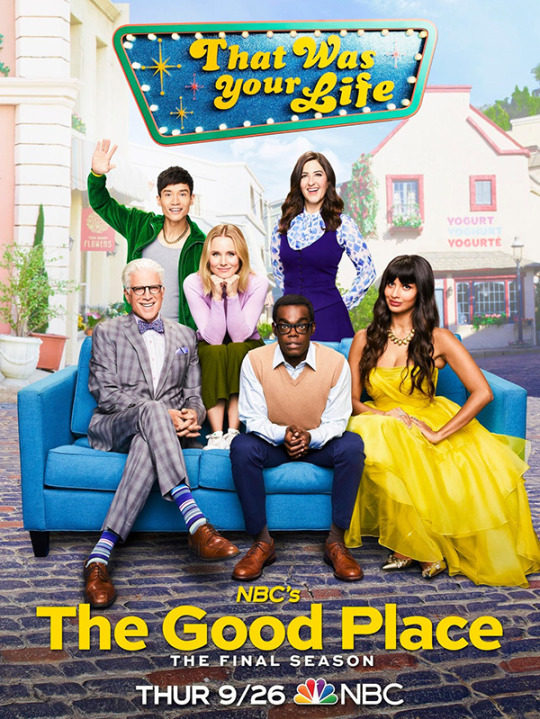
It was tempting to omit The Good Place this year or shunt it to a side category since only the final 4 episodes aired in 2020, but that would have been disingenuous. This show is one of my all-time favorites and it ended perfectly. The series finale is a representative mix of absurdist humor and tear-jerking emotion, built on themes of morality, self-improvement, community and humanity. (And this last run of eps also includes a pretty fantastic Timothy Olyphant/Justified quasi-crossover.) Now that the entire series is available to stream on Netflix (or purchase in a nice Blu-ray set), it’s a perfect time to revisit the Good Place, or check it out for the first time if you’ve never had the pleasure.
5 of the Best Things I Caught Up With
Anne With An E (Netflix/CBC)
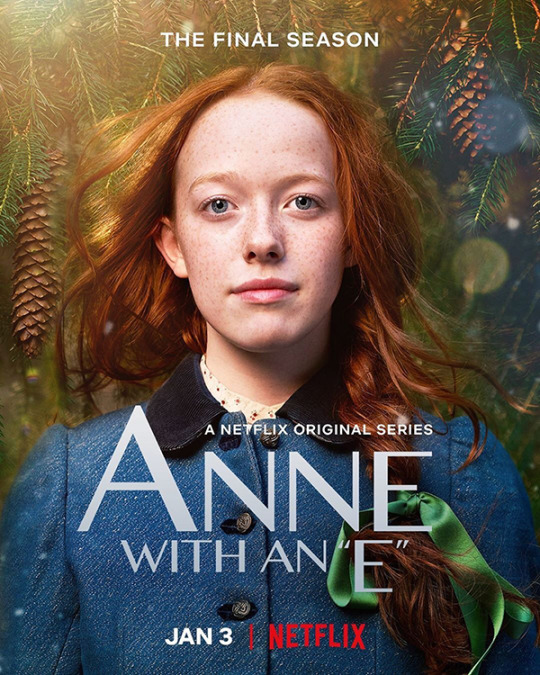
Another example of classic literature I had no prior knowledge of (see also Little Women and Emma), this Netflix/CBC adaptation of Anne of Green Gables was strongly recommended by several friends so I finally gave it a shot. While this is apparently slightly more grown-up than the source material, it’s not overly grimdark or self-serious but rather humane and heartfelt, expanding the story’s scope to include Black and First Nations peoples in early 1800s Canada, among other identities and themes. It has sadly been canceled, but the three seasons that exist are heart-warming and life-affirming storytelling. Fingers crossed that someday we’ll be gifted with a follow-up movie or two to tie up some of the dangling threads.
Better Call Saul (AMC)
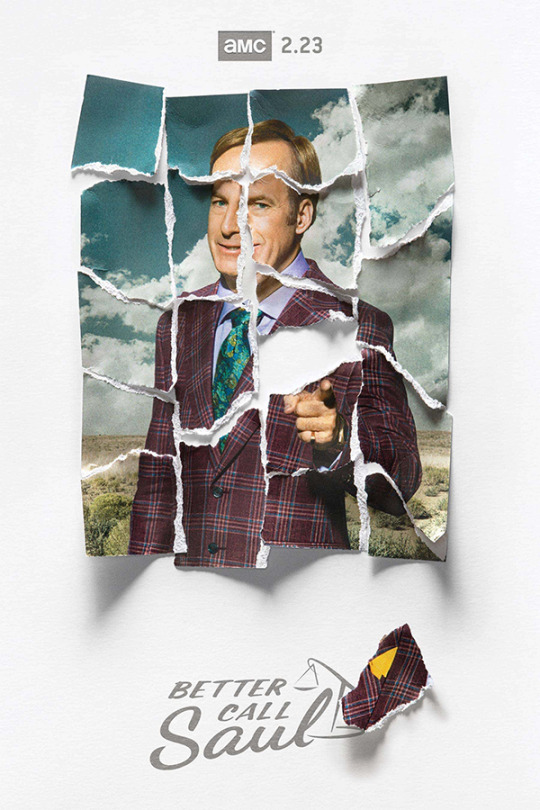
I liked Breaking Bad, but I didn’t have much interest in an extended “Breaking Bad Universe,” as much as I appreciate star Bob Odenkirk’s multitalents. Multiple recommendations and lockdown finally provided me the opportunity to catch up on this prequel series and I’m glad I did. Just as expertly plotted and acted as its predecessor, the series follows Jimmy McGill/Saul Goodman on his own journey to disrepute but really makes it hard not to root for his redemption (even as you know that’s not where this story ends).
Joe Pera Talks With You (Adult Swim)
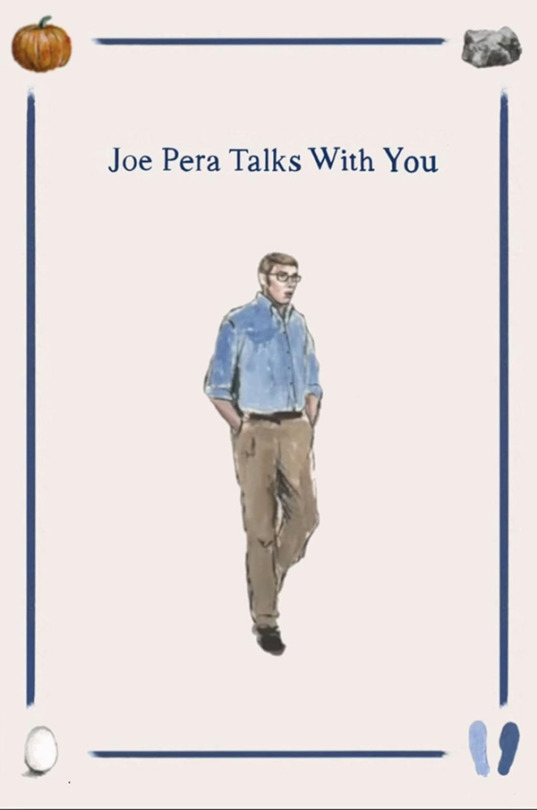
It’s hard to really describe the deadpan and oddly soothing humor of comedian Joe Pera whose persona, in the series at least, combines something like the earnestness of Mr. Rogers with the calm enthusiasm of Bob Ross. Sharing his knowledge on the likes of how to get the best bite out of your breakfast combo, growing a bean arch and this amazing song “Baba O’Reilly” by the Who – have you heard it?!? – Pera provides arch comfort that remains solidly on the side of sincerity. The surprise special he released during lockdown, “Relaxing Old Footage with Joe Pera,” was a true gift in the middle of a strange and isolated year.
The Mandalorian (Disney+)
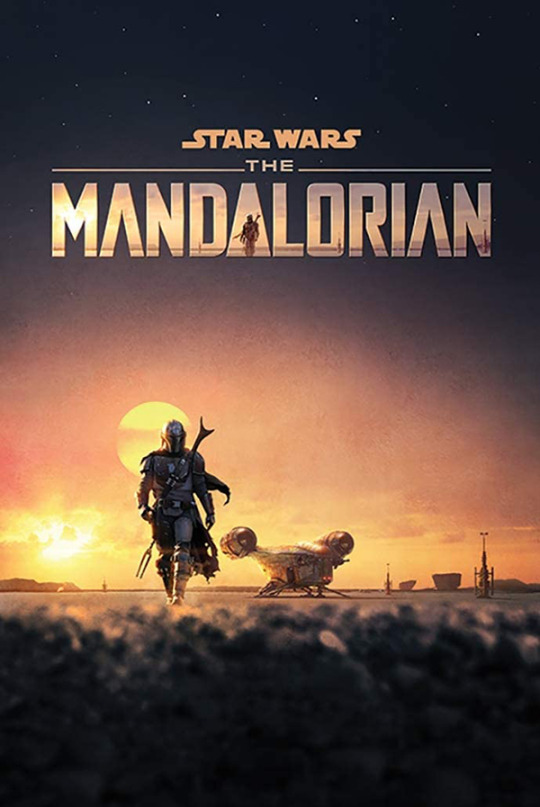
One of the few recent Star Wars properties that lives up to its potential, the adventures of Mando and Grogu is a real thrill-ride of a series with outstanding production values (you definitely want to check out the behind-the-scenes documentary series if you haven’t). I personally prefer the first season, appreciating its Western-influenced vibes and somewhat-more-siloed story. The back half of the second season veers a little too much into fan service and video game-y plotting IMHO but still has several excellent episodes on offer, especially the Timothy Olyphant-infused energy of premiere “The Marshall” and stunning cinematography of “The Jedi.” And, you know, Grogu.
The Tick (Amazon Prime)

I’ve been a fan of the Tick since the character’s Fox cartoon and indie comic book days and also loved the short-lived Patrick Warburton series from 2001. I was skeptical about this Amazon Prime reboot, especially upon seeing the pilot episode’s off-putting costumes. Finally gaining access to Prime this year, I decided to catch up and it gets quite good!, especially in Season 2. First, the costumes are upgraded; second, Peter Serafinowicz’s initially shaky characterization improves; and third, it begins to come into its own identity. The only real issue is yet another premature cancellation for the property, meaning Season 2’s tease of interdimensional alien Thrakkorzog will never be fulfilled. 😢
Bonus! 5 More Honorable Mentions:
City So Real (National Geographic)
The Good Lord Bird (Showtime)
How To with John Wilson: Season 1 (HBO)
Kidding: Season 2 (Showtime)
Unbreakable Kimmy Schmidt: Kimmy Vs The Reverend (Netflix)
11 notes
·
View notes
Text
Carl Reiner (1922 - 2020)
Betty and Dick Dixon would put their three sons to bed by nine o’clock at night in 1962, then settle in for a little TV viewing before turning in themselves.
Betty would fold laundry or do some sewing sitting on the couch while Dick, not much of a TV viewer unless it was sports or news, would read the paper for ten to fifteen minutes before dozing off in his big green overstuffed armchair.
Rikk and Robert Dixon may very well have been asleep along with their dad come nine-thirty, but on Wednesday nights little Buzzy boy lay awake and alert in bed, listening to the faint TV sounds in the living room, waiting for a familiar theme to start playing.
When it did, he carefully crept out of bed, down the hall, and into the living room, crouching behind his father’s chair while Dick Dixon snoozed away, peering over the top like Kilroy in the old WWII graffiti.
He was there to watch The Dick Van Dyke Show, and today, sadly, he’s here to commemorate the incredible genius behind it and to acknowledge a debt that can never be replayed.
I’ve posted elsewhere about how I gravitated to the art of story telling at an early age, already analyzing and dissected the way stories were told even before I knew what I was doing. The Dick Van Dyke Show was tailor made for me, even at the age of eight.
Seriously, what’s not to love?
It was a series about a lucky guy with a happy home and a wonderful wife and the greatest job in the world: Hanging out all day with two great and funny friends, doing nothing but coming up with ideas and skits and stories, all of which end up being broadcast on a popular TV show.
For 90% of the writers of my generation, The Dick Van Dyke Show proved to be the single greatest career inspiration.
And we can all thank Carl Reiner for that.
. . .
Go ahead and Google him; you’ll find more info that I can pack into this wholly inadequate obituary.
The man was a creative genius with no misplaced ego. Whatever worked, as long as it made the final project better.
Reiner was hilarious in person, but he also knew when to let someone else shine. He and Mel Brooks performed a long running free-form improvisational routine called “The 2,000 Year Old Man” in which Reiner would play a reporter interviewing Brooks, the aforementioned 2,000 year old man.
The secret to a good comedy team is the straight man. It’s the straight man’s job to guide the performance of the comic, to steer them away from failing ideas and back towards laugh getters. When comedy teams split up it’s typically because either the straight man wants to be recognized as equally funny, or (more commonly) because the comic thinks they can do it on their own.
Reiner and Brooks revived the 2,000 Year Old man again and again and again, never running out of material. Never once did Reiner try to one-up Brooks -- and never once did Brooks think he could do the routine all on his lonesome.
It takes supreme self-confidence to step back and let somebody else get the spotlight, but Reiner could do that.
The Dick Van Dyke Show wasn’t supposed to be a show about Dick Van Dyke.
It started life as a pilot called The Head Of The Family and other than living in a New York brownstone instead of a ranch house in New Rochelle, it was pretty much the same show that became one of television’s all time classic sit-coms.
Only it starred Carl Reiner.
For reasons best known to CBS, the suits decided they wanted Van Dyke, then an up and coming stage actor, to carry a show based on Reiner’s personal life experiences.
Reiner graciously ceded the point and stepped back.
Would The Head Of The Family have been the big hit The Dick Van Dyke Show was?
Maybe; maybe not.
Casting chemistry has a lot to do with the success of any production.
But it sure would have been just as funny.
. . .
Another aspect of Reiner’s comedy sensibilities is that his work never felt meanspirited.
Ph, he could skewer inflated egos with the best of ���em, but he never belittled or demeaned his characters.
The Comic is a sadly underrated drama he made with Dick Van Dyke about a has-been silent movie comedian. We find ourselves laughing at first, but by the end of the picture we come to realize it’s not a comedy but rather a tragedy with some grimly comic bits.
Where’s Poppa? is another underrated film, against bypassed by most audiences as a morbidly comic film, but again, it’s not.
Rather, it’s a sad yet humorous story about an adult child desperately trying to cope with a parent sliding deeper and deeper into dementia with each passing day.
Reiner’s writing always showed he wanted good things to happen to his characters -- all his characters.
He wanted them to learn, he wanted them to rise above themselves, he wanted them to be better people than they thought they were.
And the humor came in their failings, true, but the failings were never the climax of the story, just act two.
And while Reiner could be passionate in striving for things he believed right, and strenuous in his opposition to those whom he felt inflicted harm, at every step of the way one could sense he hoped the other side would have a flash of insight, a moment of awakening when they’d recognize what they were doing and turn away from it.
Carl Reiner knew the difference between justice and retribution.
. . .
I met Carl Reiner briefly once at Howie Morris’ funeral (see what he and Carl and Sid Caesar could do together here). I exchanged a few Tweets with him; he was kind enough to respond to a few comments I posted.
I did get to tell him how much The Dick Van Dyke Show influenced me, not just professionally but personally, and while I think he heard that a lot from many, many other writers, I think he appreciated it every time.
No bask, not preen, not strut in pride, but appreciate that something he did made such an impact on literally thousands of other people that it changed their lives.
No, we didn’t all go on to be big time TV writers -- let’s be brutally honest, I’m a piddlin’ size fish in the tiny pond of TV animation -- but it gave us something to aim for, something to aspire to.
Even those who never made it in show biz gained something from that show, and I’ve never heard anyone regret any decision they made based on it.
So again, thank you, Carl.
You made a huge impact.
The world is not just a different place because you were in it, it’s a better place.
© Buzz Dixon
3 notes
·
View notes
Note
Mind if I ask you what you didn't like about Thor in IW? Or if you don't want to talk about that, what cake would be a thematic cake you'd design for Loki to go along with Thor's lemon one?
I can answer BOTH of these. There’ll be spoilers here so I’ll tag that but be careful.
1) i can’t seem to get the cut to work so I’ll put the cheesecake thing up top
So the cheesecake at Disneyland for Thor was a raspberry cheesecake with a chocolate Mjolnir on top. I would probably do another cheesecake but maybe with a citrus flavor to it. Like a lemon lime cheesecake with green icing on top and a little chocolate Loki helmet on top!!! But I love citrus lol
Okay spoiler filled rant beneath the cut
In Ragnarok you can tell that Taika KNEW a LOT about Thor the comic book character and cared about this character. I mean he was the first one to bring in Immigrant Song as part of his pitch for the movie which is INSANE that no one had thought …..to make Thor about a heavy metal viking in space??? because that’s EVERYTHING that made Thor appealing in the 70s-80s in a sense lol. Hemsworth was tired of playing this TOTALLY under-utilized and under-powered GOD OF THUNDER!!! And of course he’d get bored. If you go back and you look at the Thor movies on their own he’s not even really the main character in his own movies. Jane and Loki are more compelling, more story driven, given more character development and those moments you remember from Thor 1 and 2 are NOT Thor moments. (M&M wrote The Dark World which is why no one outside of die hard Thor fans really like that movie).
Taika and Hemsworth collaborated on Ragnarok. Taika’s main point was that if you’re going to have a movie about Thor he NEEDS to be the best character in the movie. A lot of people loved Ragnarok but there are a lot of people who thought it wasn’t DRAMATIC enough or MEANINGFUL enough but a man who didn’t want to be king, doing the most KINGLY things of protecting his people, sacrificing himself against a colonizing murderer even if he is a part of that family of colonizers. It shows Thor coming into his own as his own character. Taika knew how to use Hemsworth’s humor and is a great comedian on his own. All of Taika’s comedies have these really HEARTFELT moments that make the funny moments much more entertaining because you care so much about them).
Marvel gave up on Thor. Marvel Studios gave up on Thor. M&M gave up on Thor and the Russos never knew what to do with him anyway. And in a sense I kind of see why someone would fall to the wayside when you have a cast of over thirty heroes to try and be entertaining, give the audience their scenes and have people want to care about them.
When Ragnarok came out it was so under promoted that they were sure that it would flop. It wasn’t until those screeners came back or the reviews came back that people actually cared about it. Because they made an amazing movie.
Like when everyone’s contract was coming up to end Hemsworth wanted more and that was all Taika and Hemsworth collaborating on this character.
ALL OF THIS WAS THROWN OUT THE WINDOW WHEN THEY STARTED FILMING INFINITY WAR/ENDGAME.
I’m not gonna spoil endgame but I’ll tag it anyway but these two films were filmed at the same time. Not counting pick ups and retakes. So everything we knew about Thor in this last movie was filmed roughly at the same time as Infinity War.
Hemsworth said in an interview that he really wanted to keep what he and Taika had worked on with Ragnarok. But what are you gonna do? you can’t fight TOO much for that last movie because its the last two movies. Eventually he was convinced on what they were going to do with Thor.
Ragnarok: Thor realizes he’s more than just a weapon. Lighting COMES and flows THROUGH him. Not the Hammer. Mjolnir is what makes him fly but not what summons the lightning. He was referred to as the God of Thunder. That’s WHO HE IS. The previous movies kept emphasizing he’s not a god. Even Odin calls the Asgardians not gods which GOES AGAINST WHAT THEY ARE IN BOTH MYTH AND THE COMICS. Thor had his own humor and it worked because Taika knew how to write Thor and Hemsworth knew what to do to make him funny.
Infinity War: Somehow Thor cannot fight without a new hammer. (Its to sell toys) So lets go on this adventure ELSEWHERE to get a new fucking hammer. And then the Hammer is used ONCE. And then in Endgame he’s completely useless without his hammer??? or Stormbreaker?? Stormbreaker can use the rainbow bridge. Why couldn’t he use it to go get Tony? Granted he didn’t know where Tony was but it makes just as much sense as Captain Marvel finding him. And I absolutely love that scene but ??? Thor has this ability and used it once???
Like he has a whole conversation with the guardians and rocket about having to go get a new hammer. Why? WHY? Because he didn’t defeat Thanos?
But he’s reliant on this weapon AGAIN. Which completely defeats what we learned in Ragnarok. It just seems like they literally didn’t know what to do with Thor because Thor was so powerful. They did the same thing with Vision. That’s why Vision gets nerfed at the beginning of the movie. They LITERALLY said “We had to take Vision out early on because he’s too powerful”
Which is fucking stupid. Because if Vision is so powerful and Thanos fucking wrecks him then THANOS IS NOW MORE POWERFUL THAN VISION. The people who should be able to wreck Thanos without really any issue are Wanda and Captain Marvel because they’re BOTH birthed of Infinity Stones and so is Vision but if he can take out Vision then you have more fear for what he can do to Carol or Wanda.
Thor is one of the most powerful Avengers in the comics and throughout most of the series he’s just sorta …..really strong.
Taika tried to fix that and the Russos and M&M erased that.
Also.
We had an entire movie that proved that Thor wasn’t a complete buffoon. Thor isn’t supposed to be a Tony Stark or a Reed Richards or even a Black Widow for that matter. But he’s not stupid. Which makes Loki that much more manipulative because he’s constantly tricking Thor (granted he’s had about a thousand years to perfect tricking Thor and a mom who taught him how to be a witch so…yknow)
And there’s nothing wrong with HOW Thor fell into a depression or dealt with trauma. But his trauma wasn’t any different than Cap or Tony really but it was dealt with as a joke. And there’s always something really uncomfortable to me (even tho I did laugh at the jokes because of course I would. They’re framed as jokes and some of them land really well like when he’s asleep in the chair or when he’s telling the tale of Dark World) where being fat is being made to look like a sign of laziness or that being fat is something that in and of itself is funny or how underneath that fat is a really buff man who can take his fat off at any time and as a card carrying fat person I don’t have that ability.
I like Fat Thor. I do not like that on top of being Fat he was a complete idiot. They took everything he was good at and the humor that Taika and Hemsworth brought to the character and made it a three hour fat joke.
So I’m hoping if he shows up in Guardians or they do get Thor 4 (or Thfour) we get Taika’s involvement again and we get some writing on this character that isn’t belittling.
So basically I hate that the Russos and M&M didn’t know what to do with this character that we had to wait so long to see actually get shown in a light that wasn’t just “That Blonde Dude with the Hammer”
80 notes
·
View notes
Photo
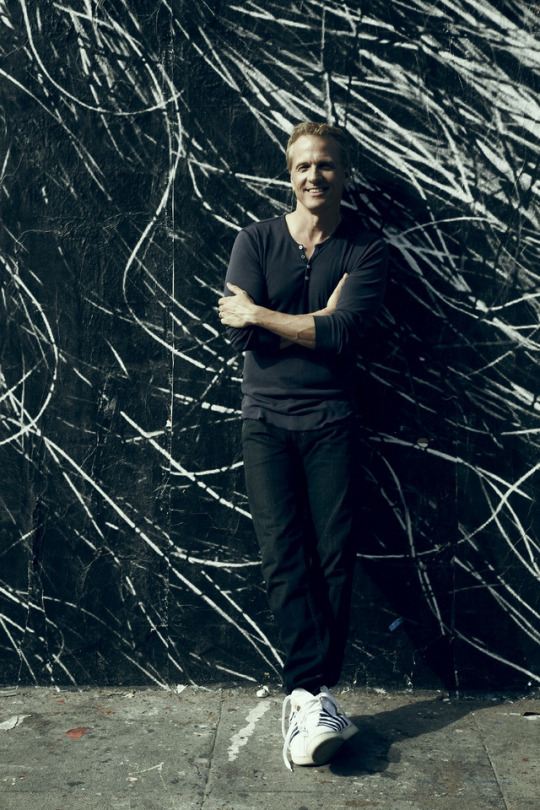
Patrick Fabian
Article by Ricky Tavi
Photo by Josh Madson
Patrick Fabian is likely one of those actors who seems to have been in so many movies we’ve seen so many TV shows we’ve watched and so many adverts we’ve listened to. And yet because his performances and characters are so diverse and convincing, it just hasn’t seemed necessary to remember his real name.
But Patrick Fabian may not be able to avoid the personality spotlight too much longer. As the season of his current CMT sitcom, ‘Working Class’ just ended, he’s looking at another critically acclaimed success to add to his nearly 20 year acting resume.
Patrick spent some time with us and allowed us to discover something of the real life personality behind the brilliant list of stage and screen characters that this fine actor has so often brought to life.
Our interview reveals a man of humor and humility. He gives us a glimpse of his Working Class co-star Ed Asner - is he easy to work with? – And, with a big smile, drops a hint about the most famous screen character he’d welcome the chance to portray. Read on to discover the fascinating background to one of Hollywood’s better kept secrets – Patrick Fabian.
In your 18 year acting career you have appeared in just about every performance medium possible – stage, movies, TV, voice-over, adverts…..the list seems endless. So starting with the most recent, and where today’s buzz is, please divulge something about the new CMT series, ‘Working Class’.
This has been a great experience and a ton of fun to do. It's a smart, funny sitcom that'll get the whole family laughing; it's a real traditional show in the vein of "Roseanne" & "Everybody Loves Raymond". If you haven't tuned in, now's the chance to see what all the fun's about. And there's gonna be some kissin'!
Do you think you were an easy choice to portray your character?
Well, I run Parker Foods and am the boss of Melissa Peterman and Ed Asner's characters, so clearly, someone in casting thought I knew how to order people around! That, and wear Armani well. I think I can bring a bit of humor and good nature to the usual traits that bosses possess.
I read somewhere that you are happy to be thought of as a ‘working class actor’. If so, are you bringing ‘real life’ to your part – albeit the show is not intended to be taken too seriously?
The show is meant to make people laugh, we're not solving the world's problems, you know? And being a working class actor, for me, means that I get to do a wide variety of roles and situations, and that I'm fortunate enough to work fairly consistently. Although, let's be clear; if you need me to be a Star, I'm open to that.
Ed Asner, one of your co-stars in ‘Working Class’, is known for his real life advocacy of the ‘common man’. What special energy do you think his outlook on life has brought to the show?
Ed's a man of his word and certainly backs up his beliefs with his actions and I respect him for that. His acting experience and skills are totally fun to work with and I've learned a lot from watching him. He's not afraid to fail in life or work.
Comments from your colleagues in the show talk of the fun and good humor that has made the production work such a pleasant experience. With so many seasoned actors are you all able to stick to the script? Is ad libbing allowed?
I can easily say it's been one of the easiest sets to work on; we laughed all the time. And that tone is set by Melissa Peterman; she's a shining light and considering the crazy schedule we were on, that's no small feat. And Melissa comes from improv, so she's wonderful on her feet and can ad-lib all day long. The writers' wrote us great material and they weren't averse to our going off the rails: we were all looking for the funny.
As an actor you’ve portrayed the deadly serious to the comic. How do you classify yourself primarily – if you do?
I think it's all about the point of view you bring to any particular role, and how that fits into the whole, you know? I'm fortunate to work in both serious and comic worlds and I like it like that. However, if James Bond ever opens up..........
Where do you have the most fun? In theater or movies?
They all have their charms, (and frustrations), but I definitely have a soft spot for live theatre; it's where I learned my craft and the immediacy of a play and it's interaction with an audience can't be beat.
All reports are that you have a great sense of humor. Could you ever imagine yourself as a stand-up comedian? Ever tried it?
I have way too much respect for stand-up to try it. I need writers. Wildly, talented writers making me look good. Daily.
As a serious actor, has Shakespeare featured much in your stage experience?
I got my Equity Card at the Shakespeare L.A. Festival years ago playing Moth in "Love's Labor's Lost". Shakespeare under the stars at the John Anson Ford Theatre in the summertime. A wonderful experience and I would kill to be at the Festival in New York City's Central Park.
Ever played Hamlet? Would you want to?
No I haven't. And yes, given the opportunity, I think every male actor would love a crack at it.
Your career has given you the opportunity for a lot of travel. Much time away from home. Now that you are a parent – congratulations, by the way, to you and your wife, Mandy Steckelberg, on the birth of your daughter Abbey Ray – will you be earning fewer frequent flyer miles?
Well, they say have a baby and the world will provide (or something like that) and so far, that has been the case, although most jobs have kept me local. I thought it would be great to get a series in New Zealand or Europe for a few years while Abbey Ray's still a wee one. But my wife has been wonderful about the work when it does take me out of town. Many of friends have managed it all, so I imagine we will too; we should be blessed with such problems, right?
What are some of your favorite place around the world?
Wandering the old streets of Barcelona, the Playhouses of London, NYC's Central Park, Muir Woods just over the Golden Gate Bridge and Will Rogers State Beach in Santa Monica, Ca.
You are one of the hardest working and most experienced actors in today’s industry – and yet you manage to avoid the excesses of the paparazzi. How do you balance keeping a private life with the demands of your work to be in the spotlight?
Well, going back to what a 'working class' actor is; I'm familiar to a lot of people because I've been in such broad spectrum of venues, but I don't necessarily stand out as one particular role, one that the paparazzi or public is that enamored or obsessed with, so I get the benefits of being known, but without the downside of being crazily sought after. (Again, if you need a STAR, however......)
You’ve been active in the union movement on behalf of stage and screen actors and others in the entertainment industry, and have held union elective office. Could you imagine a political career in the future?
I've really enjoyed my experience on the SAG Hollywood Board; it's a great reminder that you need to have personal responsibility for what goes on in your Union, or for that matter in your City, State and Nation. As much as I would be interested in a political career, I think working with a baby, a chimpanzee and Screech in a single episode of "Saved By The Bell: The College Years", disqualifies me.
It’s difficult to imagine now, that as an actor you’ve ever found yourself ‘resting’. How difficult is it to sift through the offers and scripts to find those that interest you? Are you very selective?
I love to work. And the next job is always the one I'm interested in finding out about. Different jobs rear their heads different ways; this past year has included Commercials, Low-Budget Films, 1/2 Sitcoms, Hourlong Guest Spots, Live Theatre and VoiceOver: I've been wildly fortunate and love to stay busy.
When you are ‘resting’ at home, what do you like to do for R & R?
Take walks with the whole family. (wife, baby & the two dogs) And cooking is very relaxing.
What musical preferences? Are you playing Mozart for your daughter?
I love Rock & Roll and 80's Hair Metal, but there's room in my head for lots of different things. We play a kaleidoscope of music for Abbey Ray; I hope she takes to it, but you cannot force it. (So far, Rock-a-Bye Baby: Pink Floyd is a big hit!)
What movies have you enjoyed recently?
Loved "The Social Network", "Inception" and "The Awful Truth"(Cary Grant)
Your character in “Working Class’ dresses exceptionally well for a grocery store manager! An anomaly of the storyline? Your stage and screen characters have provided just about every costume statement that could ever be made! What styles reflect your personal comfort zones?
Only on television does a store manager sport Theory, Donna Karan & Armani: What a great business! I love comfortable, horse-riding clothing; Robert Redford around 1974. And the 'Swashbuckler' wardrobe from "Xena" will be hard to top.
Can you give an idea of where you see your career progressing over the next few years? Maybe the next James Bond? Could you ever imagine living elsewhere from LA or is that almost a necessity that comes with the work?
Did you say Bond? I'd love to spend a chunk of time in New York, albeit with a steady gig. But I love Los Angeles, its home for me and my family now and I wouldn't have it any other way.
It’s clear that you are a man with an active social conscience and also a man of letters – graduate of Penn State & California State Universities. Do you have any words of advice to young actors and performers starting their careers in today’s entertainment industry?
It's the greatest business when's it's all working; and absolutely devastating when it doesn't. Don't take it or yourself too seriously. However, learn your craft. Go to school or take class, and take IT seriously.
2 notes
·
View notes
Link
Thousands of demonstrators at L.A.’s March for Our Lives rally marched from Pershing Square to Grand Park, carrying handmade signs and banners that said, “Protect kids, not guns” and “I shouldn’t be afraid to send my child to school."
Joining demonstrators around the country, tens of thousands of Southern California residents enraged by the gun violence that has ravaged American schools and other public places flocked to downtown Los Angeles on Saturday to call for stricter gun control laws.
Under grey skies, demonstrators in L.A.'s March for Our Lives rally walked from Pershing Square to Grand Park, carrying handmade signs and banners that said, "Protect kids, not guns" and "I shouldn't be afraid to send my child to school."
The sound of drums, tambourines and call-and-response chants rippled through the crowd of thousands of students, parents and grandparents and echoed off the historic buildings of Broadway's theater district.
"What do we want? Gun control! When do we want it? Now!"
At a rally in front of L.A. City Hall, Mayor Eric Garcetti led the crowd in a call and response chant: "Whose streets?" he said, as the crowd roared, "Our streets!" "Whose Lives?" "Our Lives!" "Whose nation?" "Our nation!"
The mayor said it was an historic day led by the country's future leaders, "the students who are here today."
Garcetti pointed out California's bans on assault rifles, bump stocks and waiting periods on gun sales as a model for federal legislation and closed with a message for President Trump.
"Get with the program Mr. President, or get the hell out of the way!"
Comedian Amy Schumer, cousin of Senate Minority Leader Chuck Schumer (D-New York) who also attended the march, spoke to the survivors of the Parkland shootings.
"We stand together for your senselessly slain classmates and friends and say this has to stop!"
At the end of the march, actress Rita Ora sang a rendition of the 1960s protest song "For What It's Worth," and some members of the crowd chimed in. She told the demonstrators: "You're going to inspire the whole damn world."
Crowds gathered Saturday in more than a dozen California cities, including San Francisco, Oakland, San Diego, Santa Clarita, Long Beach and elsewhere.
Speaking at an afternoon rally in Santa Ana, Lt. Gov. Gavin Newsom, touted Proposition 63, which he proposed and campaigned for, as California's answer to the NRA's sway over federal gun policy. The 2016 voter-approved initiative banned ammunition magazines that hold more than 10 rounds and makes it a crime not to report lost or stolen guns.
"We changed the trajectory of the debate, not just in this state but all across the rest of the country," Newsom, who is running for governor, said of the state's laws. "Gun control saves lives!"
Organizers with NextGen America, a group started by California billionaire and activist Tom Steyer, who has already put $1 million into a nationwide youth voter registration effort, were helping to sign up new voters in Santa Ana.
"As much as we love your voice, we want to make sure your voice is counted on Nov. 6," Steyer told the crowd. He said he plans to spend $30 million helping Democrats flip the House of Representatives this year, $3.5 million of it organizing young people in California.
At a rally outside San Francisco City Hall, U.S. Sen. Dianne Feinstein noted her support for an assault weapons ban in her tough re-election campaign and urged demonstrators to extend their activism to the November mid-term elections.
"There is a bill in the Judiciary Committee to ban assault weapons with 30 cosponsors," she told the crowd. "The problem is the gun industry. They will go out and they will support mightily people in other states that will refuse to do this. Here's what I'm asking you to do...Will you march? Will you register? Will you see that people vote and see that you vote and your friends vote for those that would rid this country of guns?"
The crowd responded: "Yeah!"
The worldwide day of action against gun violence was sparked by student activists who have pushed lawmakers to forgo campaign contributions from the National Rifle Assn. and enact stricter gun control laws in the wake of a Feb. 14 shooting at Marjory Stoneman Douglas High School in Parkland, Fla. that left 17 students and teachers dead.
In the thick of the march on Broadway, a group of teenagers that included Myles Pincus, 15, carried a long banner adorned with red handprints that read, "NRA has blood on its hands."
Pincus, a student at Fusion Academy, urged people not to conflate the issues of mental health and gun violence as they advocated for change. He said he had "myriad" mental health issues, and ostracizing people like him won't solve anything.
"I don't need to go to school and get patted down just because I have depression," Pincus said. "This is not a mental health issue. This is a gun issue, period."
Many teenagers at Saturday's rallies said they looked forward to turning 18, when they could vote for candidates who will support national gun control measures.
California election officials staffed a booth where adults could register to vote, and 16- and 17-year-olds could pre-register. The initiative, which activates teenagers' voting eligibility when they turn 18, has pre-registered more than 88,000 people since its launch in 2016.
Sheva Gross, a child development professor at UCLA, came to the march with her daughters Talia, 8, and Flora, 11. Gross carried a sign adorned with peace signs that read, "I'm so mad, I can't even think of a slogan."
The girls have gone through lockdown drills at their Culver City elementary school that make them nervous, Flora said. She added: "To not come home again, like, ever — it's overwhelming."
Gross was in the classroom with future teachers and child welfare workers 15 minutes after the San Bernardino massacre and an hour after the Parkland shooting. She said the fear in her students' eyes was evident.
"They grew up with this, and they're terrified," Gross said, breaking into tears. Flora hugged her.
Retired school principal John P. Johnson, 68, and his wife Margy came from Corona to march for their 13 grandchildren. Johnson, who knows the AR-15 well from his time in the U.S. Navy in Vietnam, held a sign that read: "Veterans against assault weapons."
"There is no reason to purchase an AR-15 here or anywhere in the world," Johnson said. "It's used for the battlefield. The bullets kill within seconds."
Brianna Cornejo-Perez, a 14-year-old student at Santa Monica High School, came to the march with her mother, a former teacher. A fellow student in Santa Monica had posted a Snapchat photo of himself holding a gun, making fun of gun control and the Parkland shootings, unnerving her.
"We used to have lockdown drills — now we have active shooter drills," Cornejo-Perez said. "It's a bit scary."
Cornejo-Perez and her mother said they support school psychologists, anti-bullying campaigns, and other resources for kids who don't fit in, rather than armed security guards or police officers.
Giselle Jimenez, 17, of Alexander Hamilton High School, held a sign reading, "Silly me, I didn't know that not wanting kids to be slaughtered by assault rifles was being political."
"A school shooting could happen anywhere," Jimenez said. "The next victims could be me, my sister, any one of my friends."
Ariel Burgess, 22, who recently graduated from UCLA, said there was a shooting the month she was accepted to the university. It made her question whether she would be safe there.
"Every shooting I'm saddened but never surprised," she said. With "every shooting, the urge to change gun laws gets stronger, but nothing gets done."
Cara Rosenbaum, 32, of Leimert Park held a sign that read, "My daughter is due in May. I'm afraid to send her to school."
She said it's terrifying to think about bringing a child into the world and having to worry every day about whether she will come home from school.
"As I'm preparing for parenthood, there are so many things I need to think about," she said. "The safety of my child while she's trying to get an education should not be one of those things."
At the end of the march, about a dozen pro-gun activists gathered outside Los Angeles Police Department headquarters. They waved American flags and held signs reading, "Ban Jihad, not guns" and "Guns will ensure our freedom."
They were separated from the March for Our Lives participants by yellow caution tape, a line of officers, a line of police bicycles, and a line of volunteers who wore orange vests and black shirts that said, "We can end gun violence."
"How long have you been pro-mass shooter?" one man shouted across the barriers.
"All lives matter!" a pro-gun protester shouted back.
Another said, "My best friend is black!"
Jarime Uzziel, 43, said he was "standing against additional gun control." He said he wants teachers to be trained and able to carry firearms.
Natali Valle, 20, stood on the other side and shook her head, pulling her friend into a hug. They had come by to see if the counter-protesters had any valid points, and quickly decided the answer was no.
"When people argue back and forth, there's no communication happening," said Valle, a student at Mt. San Antonio College in Walnut. "This division is … what's causing America to fall apart."
Times staff writer Sonali Kohli contributed to this report.
UPDATES:
6:35 p.m.: This article was updated with new comments from speakers in Santa Ana and San Francisco.
5:05 p.m.: This article was updated to include comments from speakers at an afternoon rally in Orange County.
3:50 p.m.: This article was updated to include comments from Mayor Eric Garcetti and others.
2:35: This article was updated with more comments from demonstrators.
1:35 p.m. This article was updated with quotes from pro-gun counter-protestors, and from singer and actress Rita Ora.
12:30 p.m.: This article was updated with more quotes from demonstrators.
11:50 a.m.: This article was updated with more comments from demonstrators and more details about other marches around Southern California.
10:20 a.m.: This article was updated with new comments from demonstrators.
This article was originally posted at 8:40 a.m.
4 notes
·
View notes
Text
(HOT TAKE) Quarantine Phenomenology: The Curious Case of Daddy Conte, by Denise Bonetti

‘Teenage by design’? SPAM founder and editor-in-chief Denise Bonetti, tapping into her Italian roots, takes us on a whirlwind journey around the lustful theme park that is meme space in the time of quarantine. For many, especially those who aren’t on the frontline as key workers, self-isolation is thrusting us back into a rude adolescence. Having exhausted our usual channels of recursive entertainment, where better to look than to the political (yes, wybi?!) heroes of meatspace to fantasise the intimacies and reassurances we’re otherwise deprived of.
(CW: sexually explicit references)
> Comedian Dan Sebree tweeted that this whole quarantine situation is the closest any of us millennials will get to retirement. The joke is funny because it’s most likely true: the idea of people in my age bracket (mid-20s to mid-30s) ever retiring seems like a fairytale we tell ourselves to keep our boomer parents happy, something we play along to because frankly it’s easier than sharing the extent of our doubts in the future. (Find someone in their 20s who can say ‘when we all retire’ without a shred of irony).
> Sebree is right, most of us are playing retirees now. 80% of your salary to repot your plants, make sourdough, and fend off waves of existential dread here and there: not too shabby - if you used to have a stable job, that is. Things obviously aren’t so chill for quite literally everyone else: NHS workers, shopkeepers, supermarket employees, people on zero-hour contracts (which make up around 9% of all the UK workforce under 25), gig economy workers, freelancers by choice, people whose employers can’t be bothered putting them on payroll, and have therefore decided for them that they’ll have to be freelancers - the list goes on.
> Yet beyond the retirement vibes, there is a stage of life that seems even more appropriate to represent the mood that this pandemic isolation has been creating. We are feeling manic and depressive, anxious and idyllic, bored and obsessive; we have been dying our hair and we’re allowing social media challenges and email chains to make a comeback ( 😩). We’re raging that we’re being told how & when we can go out, and we want to see our friends like our life depended on it. I hate to be the one to break it to you, but we’ve all gone back to being teenagers. (For some of us, the transformation is even more literal: everyone who’s had to move back to their parents tag yourselves.)
> In ‘Glitching the Collective Mind’ a three-part essay published on SPAM a few months ago, Dan Power noted how ‘spending too long online (or rather, too long outside of the real world)’ can easily give way to ‘feelings of melancholic or manic absurdity’ by way of ‘saturating the mind’ with the infinite possibilities of content. In the same essay, Power reflects on the nature of the virtual space this content is localised in, what Grafton Tanner has called the ‘virtual plaza’: a non-place through which ‘we drift and consume, lulled by the saccharine tones of muzak’. Power argues that what the ‘non-local’, ‘homogenized’ structure of the virtual plaza takes away is precisely that something around which the occupants can build a sense of identity: ‘When the features which distinguish one place from another are removed, stable sense of belonging and understanding are removed with them’.
> Although Power could not have predicted this current weirdness, I am interested in his linking the internet’s hypertrophic, endless-scroll format, eradicated from any sense of place as we know it, to its capacity both to strip us of our identity, and to reduce us to a melancholic, manic mess - a passive, wide-awake anonymous content-consumer, lying in bed between waves of anxiety. A teenager who is grappling with their identity because they’re not quite sure where their emotions are coming from - literally and metaphorically.
> Critic Amanda Hess has recently written in The New York Times about the comfort of playing childhood video games during the lockdown. ‘It’s not so much that I miss my childhood’, she writes as she becomes re-obsessed with her 11-year-old self’s favourite game, Myst, ‘as that I feel seized by it’. And I, currently taking a break from a 12-hour The Sims 2 Bon Voyage build-mode marathon to write this, can only confirm such claims.
> I’m sure the fact that we gravitate towards this simple kind of pastime has a lot to do with the fact that no one can be arsed engaging with highbrow content during such traumatic times. (Let me take a break from following the dead count on BBC News by watching Battleship Potemkin, said no one ever.) However it’s not only that we’re drawn to accessible content, it’s that we are drawn exactly to the kind of activities that our teenage selves used to be into. (Otherwise, explain why The Sims 2 is having a resurgence - sixteen years after its release [!], and not either of its two successors.)
> If nostalgia is generally understood as originating more in the disappointments of reality than in the draw of the object of nostalgia itself, then the grimness of the pandemic is also to blame for the current millennial vintage trends. As Hess observed elsewhere, the quarantine has forced us into lockdown with the very devices designed to amplify our obsessions, cranking up that very fixative impulse that makes adolescence the curse and blessing that we all know.
> In Italy, where the full lockdown has been going on for over 5 weeks now, the signs of this 30-going-13 epidemic are in full swing. Everybody knows about Italians competing with each other on who can sing the cringiest medley of 00s songs from their balconies. But there’s something even more beautiful that the Italians are doing, and The Answer May Shock You. Platonic love has infiltrated every corner of Italian social media, and the object, I tell you, is no one other the prime minister Giuseppe Conte.
> Just like teenage love, the obsession is platonic socially-distant just as much as it is carnal. ‘Giuseppe Conte’ has reportedly been amongst the most searched terms on Pornhub over the last few weeks. Spurred by sheer investigative rigour I decided to carry out further research on the platform, and can confirm that the PM-themed content abounds. The material itself varies from adorably chaste, SFW picture montages of the prime minister (‘ITALIAN PRIME MINISTER GIUSEPPE CONTE MAKE YOU CUM HARD’, as uploaded by user TheMinisterOfLove), to the literal hour-long speeches that the PM has delivered to the senate, to more visually explicit heart-reacts to the government’s directives (‘HUGE CUMSHOT WHILE LISTENING DADDY GIUSEPPE CONTE’).
> Pornography aside, the memes have taken over the Italian gram and Twitter. It all started when influencer and entrepreneur Chiara Ferragni regrammed to her 19.5m followers a post by the Instagram page @daddy.conte back in March, erroneously crediting it to @lebimbedigiuseppeconte (Giuseppe Conte’s Little Girls) - now two of the most popular hormone city pages dedicated to the PM. The content is genuinely too much and too good for me to present exhaustively, but I need to show you some favourites so you can get with the vibe (all from @daddy.conte):
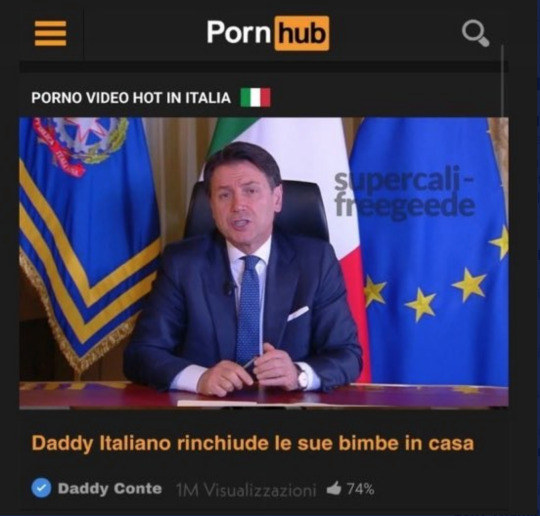
[‘Italian daddy locks his girls home’]

[’From today, I declare your smile illegal’]

[’There’s a smile underneath that face mask’]

[’hey baby’ / ‘daddy come to me, my parents aren’t home’ / ‘WHAT’]

[’don’t you dare get close to my girls’]

[’who wants a goodnight story?’]

[’Hi gorgeous, if you’re reading this it’s because i’ve been trapped in a wormhole the only way for you to free me is to stay home until 4th April please do it there is no time i know you can save me baby’] [lol at how quickly this has aged]
>The spinoffs quickly proliferated, I’m talking dozens and dozens of pages devoted to the PM’s fatherly aura and classic good looks - most of them with not a huge amount of followers; a sort of decentralised, massively participatory network of adolescent erotic surplus. Some of these pages specialise in things like the PM’s smile or dimples (for the more faint of heart), inscribing the phenomenon in that Renaissance love lyric convention of praising the object of love’s beauty through a catalogue of their body parts.
>A similar sexy/cute type veneration also seems to have developed radially around other Italian political figures such as President Sergio Mattarella, however predicated on a completely different set of desirable traits. Conte’s cult is all about a sort of sub/authoritarian kink power dynamic: ‘Dom daddy tell me what to do’. (Problematic? Potentially. However, wholesome? Absolutely). Mattarella’s cult is inevitably linked to the Italian President’s political function, that of protecting the Constitution, coordinating the three branches of government while heading none. A sort of hands-off grandaddy figure there to break up fights, if you will. Combined with his sweet mannerisms, the result is more of a GILF, sitting-together-on-the-porch kind of desirability, as hinted at by the following meme: (@lebimbedisergiomattarella)

> As a testament to this systematic linkage between quarantine and teenage emotional turmoil, the same dynamic of desire has also developed around political figures in the US. Foremost examples are New York Governor Andrew Cuomo (who we now think might have nipple piercings), and Kentucky Governor Andy Beshear - a ‘clean-cut sex symbol for the coronavirus age’ according to this Salon article explaining how ‘his calm and empathetic leadership’ (read: wholesome daddy energy) have thousands of thirsty people in self-isolation lust after him (via memes, of course).
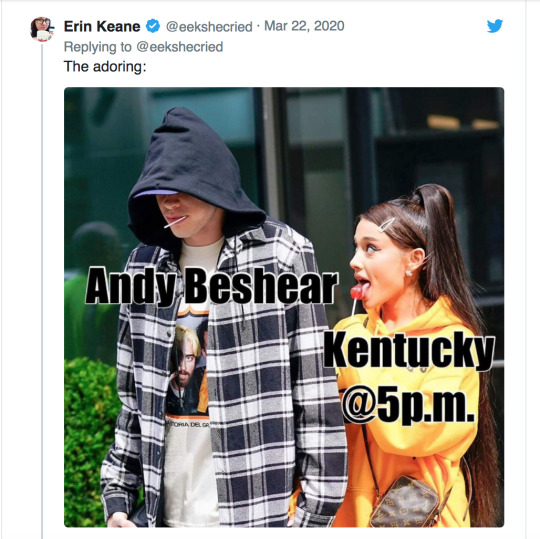
> The ethos of memes in general is already teenage by design (hypertrophic, impulsive, obsessive, thriving on a sort of possessed desire towards repetition that I refuse to compare to masturbation). But there’s something special about the dreamy, sublimated, Platonic, cute-aggressive nature of these memes in particular that makes them the epitome not only of #quarantinevibes, but also of the virtual plaza’s mood, more broadly. Quarantine has exposed and legitimised, exacerbated and normalised, the internet’s power to make us regress into horny, anxious blobs. And memes like these are the very crystallisation of that ambivalent process.
> Analysis aside, we love a meme (always already), and we love a femme fandom moment. We stan the birth of a wholesome masculinity mythology for 2020. I can think of worse Internet Utopias. Now back 2 The Sims.
-
Text: Denise Bonetti
Lead Image credit: @onlyconte (Instagram)
Published: 17/4/20
#essay#essays#Denise Bonetti#masculinity#memes#meme#Giuseppe Conte#Italy#sexy#quarantine#coronavirus#hot take
0 notes
Text

Why Louis CK broke my heart / Can the work be separated from its creators’ abhorrent acts?
When it comes to comedy, I am the epitome of tough crowd. Properly laughing whilst watching something doesn’t happen all that often. A slight smile or a general sense of amusement - sure! But to get me laughing out loud takes a LOT. [I would just like to point out this applies to TV/film/standup/theatre etc - my family & friends make me LOL all the time :)]
So when my husband suggested we watch Louie all those years ago, I was reluctant as ever. One episode in and I was SOLD. The writing, the performances, the tone captivated me in a way no other comedy show had done before. It was rip-roaringly funny whilst tapping into universal truths about life, love and parenting. I will forever remember the tooth brushing scene with Jane, EVERY episode Pamela Adlon was in, So Did The Fat Lady episode with Sarah Baker (so brutally honest and touching), Louie’s poetic conversations with the doctor re: his failed relationship with Amia, the duckling episode - the list goes on and on. I would laugh one second and get all teary the next.
And so, naturally, Louis CK became “my” comedian. I watched all the Netflix specials. I watched films purely because he was in them. My husband and I bought seriously expensive tickets for a stadium show in London and I even tried watching Baskets! I would quote his jokes and play clips of his standup to anyone who’d show remote interest.
Louis CK joined the exclusive list of “my people” - musicians, writers, actors, CREATORS who have the special power to move and inspire me with their work by either speaking my truth or challenging me to see the world in a different light.
So when the Louis CK story broke out couple of days ago (“it’s just rumours”) and again yesterday (CK confirms it’s all true), I was shocked. I do not personally know Louis CK and so, his actions should have no impact on my life. Except they do. Because here is the guy who makes the work I love, work that makes me laugh, makes me think, stays with me. And this same guy has abused his power and exposed himself to women who did not ask for it or gave their permission for it to happen. I felt betrayed.
Of course, being good at your job does not necessarily make you a good person. I know this. And still, in my head, my heroes are out there living their lives with grace, kindness, love and respect for others, right? WRONG!
So, what do I do next time I feel like watching CK’s work? Does it mean that by seeing his shows/standup/films I am excusing his behaviour? Can the work be separated from its maker? I know I’m not the first one to ask this question (look up poet Pablo Neruda for example) and I certainly won’t pretend I have an answer.
Louis CK did an awful thing. Compulsion or not, he should’ve known better. I am glad these women came forward and I hope many more find the courage to do so because men like Weinstein, Spacey and CK must be held accountable. They also serve as reminders to all other men in power, be it in Hollywood or elsewhere, that you should think twice next time an urge to sexually harass someone comes over you.
For me, Louis CK’s work will forever be tainted by these events. I will never understand how a man so clever and funny can also be a man who thought it was ok to behave in this way. Or even worse, who thought his power would protect him from these stories coming out.
Feeling betrayed by your heroes is sad. But it is nothing compared to what these women had to go through.
Time to find some new heroes!
2 notes
·
View notes
Photo

Takhuk
October 29, 2019
Michele Moore Veldhoen
Are we Living in a 21st Century Version of Wonderland?
Our recent election triggered in my mind thoughts of Lewis Carroll’s nonsensical Wonderland. Did you ever read Alice’s Adventures in Wonderland? Not until I was an adult reading them aloud to my kids did I experience my first (and, now that I think of it, only) reading of nonsense literature. The book was a surprise. I had been under the misconception that Alice’s adventures would annoy me. I was too serious of a reader then to consider nonsense worthwhile. As I discovered, Carroll was not just writing to entertain children. He was also using nonsense to satirize British Victorian society’s strict and prudish rules of etiquette, which, apparently, were in glaring contradiction to the way the English had behaved for centuries before that era unfolded. Here’s what Wikipedia says about Victorian morality:
“Between 1780 and 1850 the English ceased to be one of the most aggressive, brutal, rowdy, outspoken, riotous, cruel and bloodthirsty nations in the world and became one of the most inhibited, polite, orderly, tender-minded, prudish and hypocritical. https://en.wikipedia.org/wiki/Victorian_morality
I suppose Carroll, as a writer, was quite drunk with the fodder offered by a society that evolved in just a few decades from being outspoken and rowdy to prudish and polite. Since he lived throughout the era, he likely watched in horror as men had to be more and more circumspect in their manners around women, whose crinolines grew wider by the month. As for children, well, they were best seen but not heard.
If Carroll was alive today, he might suffer writer’s block. There’s just too much fodder for words.
We see it all these days, aggressive, cruel, bloodthirsty right alongside tender-minded and orderly.
While Carroll’s Wonderland skewers politicians, royalty and adults in general, it is first, a book of entertaining nonsense for children.
But I do feel Carroll was also contemplating some sobering ideas. This may be why his book came to mind this past week.
A quick refresher - Alice is an adventurous girl who flings caution aside and follows a rabbit down a rabbit hole to indulge her curiosity. She wanders through Wonderland, meeting a fantastical array of talking creatures, rabbits, cats, lizards, birds, mice, ducks and dogs, with whom she has absurd or nonsensical and therefore frustrating conversations. But Alice is not afraid to argue with these adult sounding creatures, a fact which no doubt gave young Victorian readers great satisfaction. She was also not afraid to simply blow off the worst of these characters and carry on with her adventures through Wonderland.
Carroll was making a hero of Alice but was he also saying to his readers not everything in this world makes sense, adults least of all, and trying to make it so is futile.
Nor is Alice afraid when she meets sinister characters such as the Queen of Hearts who orders Alice’s beheading on every other page. During the trial of the Knave of Hearts, Alice stands up to the Queen’s insanity, defending the Knave fearlessly. She survives the episode, head intact.
Was Carroll telling children to speak truth to power? Was he saying: Queens and those with authority are mad and dangerous, you must speak up?
Like many of us in Canada, I have been thinking lately about the world’s current state of political turmoil. The wacky disorientating world Alice experienced seems a good analogy. The general sense of total, utter, nonsense that imbues Carroll’s 19th century Wonderland is a fair comparison to today’s incomprehensible state of affairs. Hookah smoking, mushroom munching caterpillars and all.
Like that stoned caterpillar Alice could not understand, today’s politicians of every stripe around the world talk nonsense, evade questions and generally talk in circles. Worse, some, even here at home, break the law, neglect to mention the facts, spread lies, scorn the poor, scorn entire populations, scorn scientists and journalists, scorn anyone that does not agree with them. The contortions and rages some of them get themselves into is a sight to behold and makes me sometimes want to send them relief in the form of a good long dunk in a cold mountain lake.
Of course, in the records of organized human society, there is nothing new about any of this behavior. Power corrupts us and has been corrupting us from the first opportunity. What is new for us, or at least me, is the breakdown of so many governments that were built over decades and in some cases centuries to guard against such corruption. We have had the luck now and again to enjoy the rise of truly good leaders – many at the community level, some at the highest levels, who recognized the danger of concentrated power and created institutions and organizations to limit it in the hands of government. Because history has proven over and over that corrupted leaders produce in society intolerance, extremism, violence, and war.
These days, attempts are being made by many corrupted politicians and others to dismantle or discredit the institutional structures upon which much of the peace and prosperity of the world has been built. These are the ones I would dunk in a nice frigid Rocky Mountain alpine lake.
In Alice’s Adventures, there is no plot. No purpose. No goal or endgame. There is only a series of increasingly bizarre interactions and conversations that culminate in Alice’s final exchange with the Queen of Hearts who, when she shouts “off with her (Alice’s) head”, causes Alice to lose her temper and take a swipe at the Queen. Suddenly, the Queen and all her court are just a pack of cards, which moments later become leaves Alice’s sister brushes away from her face in order to wake her from her dream.
Are we all dreaming today’s Wonderland? When will we wake up? What is our endgame, our purpose, our goal? Is it not what we have all believed throughout our lives, to create and live in peace and mutual prosperity?
Is it true that
not everything in this world makes sense and trying to make it so is futile.
Oh yes, there is definitely futility in trying to explain everything we do. But do we not hear around the world too many excuses for intolerance and greed masquerading as necessary action or inaction? Does it make sense, for example, to fuel war on a continent (Africa, for example, where war materials are sold by almost every country you can think of including Canada), only to then have the millions who run from the devastation come to the gates of those same countries in need of refuge?
Do we agree that
often, adults are mad, and we must stand up in the face of their madness to defend the innocent.
Yes, adults with unbridled power and money do indeed go mad. For many of us, just a little too much can do us in. I learned that in 1984 in Reno, Nevada. I have not gone near a slot machine since!
Real madness though, leads to serious nonsense, to the seriously absurd. It leads to those fleeing war and violence being branded criminals instead of victims. It leads us over cliffs. Down rabbit holes.
Despite the disorienting and disturbing nature of today’s politics, I do believe that sensible heads will prevail here in Canada and elsewhere. The extreme absurdity that this world wide epic struggle for power is producing will, one day, be remembered, not as a dream like Alice’s, more likely a nightmare. But even nightmares come to an end. We do know how to climb out of rabbit holes.
Let’s go out from this weighty blog with something light, shall we?
First, from Will Rogers:
"Everything is changing. People are taking their comedians seriously and the politicians as a joke."
Next, from Tom Blair:
Politicians are like diapers. They both need to be changed often. And for the same reason.
And, from John Lennon:
If someone thinks that love and peace is a cliché that must have been left behind in the Sixties, that’s his problem. Love and peace are eternal.
So, friends, Love. Peace. Have a beautiful day in Wonderland.
0 notes
Photo
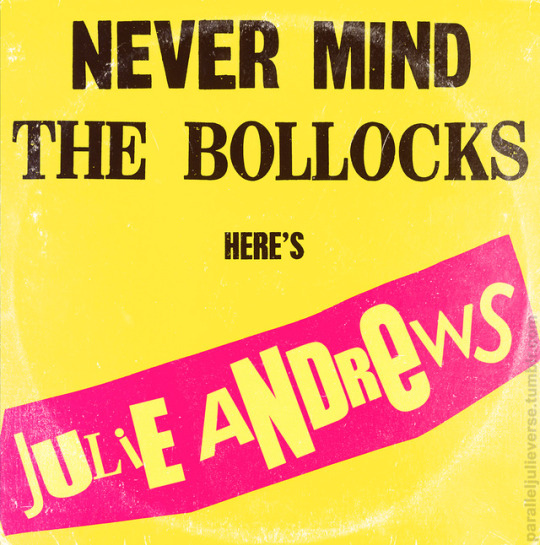
Julie Andrews Fantasy LPs #9
Super-cool-Dame-Julie-sings-the-punk-songs-of-Sid-Vicious! Even though the sound of it is something quite suspicious, If you play it loud enough you’ll always sound seditious, Super-cool-Dame-Julie-sings-the-punk-songs-of-Sid-Vicious! Um diddle diddle diddle, um diddle oi! Um diddle diddle diddle, um diddle oi!
____________________________________
When Julie Andrews was honoured with a Special Lifetime Achievement Award at the 53rd Annual Grammys in 2011, media reports took considerable delight in the incongruous sight of the genteel Dame alongside fellow honorees, pioneering US punk band, The Ramones. Photos of Julie sandwiched between Tommy and Marky Ramone, the latter draping his bared, tattooed arm proudly around her shoulder, featured in online and print news stories around the world with commentaries typically drawing amused attention to the “diversity” of the year’s honorees.
Despite the apparent novelty of the odd juxtaposition of “Mary Poppins” and a hardcore punk rock band whose catalogue of hits include numbers like “I Wanna Sniff Some Glue”and “Gimme Gimme Shock Treatment,” there is in fact something of a history of associations between Julie and punk rock.
One of the earliest recorded instances is a parody piece from 1980 by British comedian Mel Smith, made in collaboration with Queen drummer, Roger Taylor. Titled “Mel Smith’s Greatest Hits”, the song is a comic pastiche of the angry male punk anthems of the time with Smith growling about wanting to “jump up and down to my favourite sound...Julie Andrews Greatest Hits.” Elsewhere in the song, he snarls:
Julie drives me frantic Cos I'm a bit of an old romantic And she sounds so nice and she's so precise I'm in paradise with me Edelweiss
Released as a 7″ single, the front sleeve featured cover art of Smith dressed in full Adam Ant-style punk regalia, striking an air guitar pose in the middle of a bedroom bedecked with Julie Andrews memorabilia. The rear sleeve had a similar shot of Smith drooling in mock-lasciviousness over a poster of a beatifically smiling Julie. While clearly tongue-in-cheek, the Smith song signalled an irreverent collocation of Julie and punk culture that would find other, more authentic, expressions as well.
Indeed, in the very same year of 1980, a post-punk experimental outfit “The 49 Americans” released a self-titled EP with a brief track called, simply, “Julie Andrews (A Tribute)” (1980). Engineered by Andrew "Giblet" Brenner, “The 49 Americans” was a collaborative group that developed out of the London Musicians Collective in Camden (Reynolds, 187-188). Inspired by the DIY experimentalism of punk, the group placed a premium on unregulated improvisation with an open, fluid membership and a single rule that players had to swap instruments -- which could be anything from a piano to saucepan lids -- from number to number with the result that they’d often be performing with little or no technical proficiency. The “Julie Andrews” track was allegedly inspired after the group spent an evening watching tapes of Mary Poppins and The Sound of Music and consists of a discordant version of “Do Re Mi” played on a children’s xylophone with non-verbal vocals, (Masters, 112). It was re-released as part of the group’s debut 1982 LP, “Too Young To Be Ideal”, which was honoured in The Wire magazine’s list of “100 Records That Set the World on Fire (While No One Was Listening)” (Barker et al, 1998).
Other examples of Julie references in punk rock include: “Topless Mary Poppins”, recorded in 2004 by London-based Celtic punk group, Neck; the summarily titled “Julie Andrews” by the Liverpool pop-punk outfit, The Down and Outs, released as a limited run single in 2007; and, most recently, a 2017 release also called “Julie Andrews” by Noose, a self-described four piece rock punk band from Nottingham. Sporting lyrics like, “I wished my baby was like the girlies in the porno movies, But it turns out she was just like Julie Andrews from The Sound of Music,” these songs turn on a kind of shock tactic of mixing the sacred and the profane, arguably something of a stylistic signature of punk.
Dick Hebdige (1979) famously theorises punk as a “revolting style” whose subcultural disaffection was expressed through a spectacular “bricolage” of appropriated cultural “signs” (106-112). The disordered cacophony of punk music or the riotous mish-mash of punk fashion effect a representational rebellion of “semantic disorder,” he asserts, wherein categorical boundaries are dissolved and ordinarily discrete elements are thrown together in perverse combinations that contravene received “rules” of taste and decency (90). Like a portrait of the Queen with a safety pin through her lip, the family-friendly wholesomeness of Julie Andrews was a resonant symbol of mainstream culture ripe for punk subversion.
There is however another, possibly more interesting, reading of punk’s incorporation of Julie Andrews as other than a simple target for anti-establishment iconoclasm. In a fascinating article, Ruth Adams (2008) argues for punk, at least in its influential British forms, as part of a long history of populist English cultural dissent. In punk, she writes,“[b]its and pieces of both officially sanctioned and popular English culture, of politics and history were brought together in a chaotic, uneasy admixture...that arguably spot lit the very institutions that it nominally sought to destroy” (469-70). The Sex Pistols, in particular, are interpreted by Adams as “inheritors of the English music hall tradition -- the heirs to the crowns of Arthur Askey and Max Wall, operating outside the ‘legitimate theatre’ and characterized by clownish outfits, silly walks, smutty jokes and cocking a snook at the Establishment” (470).
Far from seeing them as antithetical opposites, this reading places punk and Julie Andrews on something of an artistic continuum -- albeit at divergent extremes -- with both drawing performative and professional energies from the riotous traditions of popular English carnivalesque and working-class musical theatre. Indeed, it’s instructive that the two music hall comics cited by Adams as historical precedents for the Sex Pistols -- Arthur Askey and Max Wall -- actually performed alongside Julie during her long juvenile career on the British variety circuit (Andrews, 150-51). Even after she made the leap to “legit” theatre and Hollywood stardom, the topsy-turvy irreverence of music hall continued to form an integral part of her oeuvre and persona, as evidenced from My Fair Lady to STAR! to Victor/Victoria, from Heartrending Ballads and Raucous Ditties to The Julie Andrews Hour to Julie and Dick at Covent Garden.
It’s possibly for this reason that, alongside the more predictable deployments of Julie as object of punk’s anarchic negationism, she also features as a subject of acknowledged admiration, even inspiration. This seems particularly true of female punk artists, many of whom regularly cite Julie as an important influence. Gina Birch, founding member of post-punk British band, The Raincoats, singles out Julie as a major formative inspiration (Reddington, 27), as does Kathleen Hanna of Bikini Kill (Juno, 89). In her memoir, Laurie Lindeen (2007), lead vocalist for 1990s grrl punk band, Zuzu’s Petals, even jokes:
“‘What women have influenced you?’ is a very broad question that we are asked every day. We yawn the usual: ‘Patti Smith, Chrissie Hynde, Deborah Harry, and Exene,’ when I should say, “Louisa May Alcott, Julie Andrews, and Carly Simon’” (202)
Pop superstar, Gwen Stefani, who rose to fame as lead singer of ska-punk band, No Doubt, makes no bones about her lifelong adoration of Julie Andrews. She loudly proclaims The Sound of Music as “her one true love” and is said to have cried with joy when Julie granted permission for her to riff vocals from “The Lonely Goatherd” for the 2007 hit single, “Wind It Up” (Apter, 27). Another current pop superstar, Lady Gaga -- who though not directly punk certainly draws heavily from traditions of punk rock -- is equally fulsome in her enthusiasm for Julie, as profiled in an earlier post here in the Parallel Julieverse.
All of which ultimately suggests that this imaginary LP of Julie singing the songs of the Sex Pistols is possibly not as far-fetched as it might at first seem! Oi!
Sources:
Adams, Ruth, 'The Englishness of English Punk: Sex Pistols, Subcultures, and Nostalgia.” Popular Music and Society. 31: 4 (2008): 469–88.
Andrews, Julie. Home: A Memoir of My Early Years. New York: Hyperion, 2008.
Apter, Jeff. Gwen Stefani and No Doubt: Simple Kind of Life. London: Omnibus Press, 2007.
Barker, Steve et al. “100 Records That Set The World On Fire (While No One Was Listening).” The Wire. 175, September 1998: 22-40.
Hebdige, Dick. Subculture: The Meaning of Style. London: Methuen, 1979.
Juno, Andrea, ed. Angry Women in Rock, Vol. 1. San Francisco: Juno Books: 1996.
Lindeen, Laurie. Petal Pusher: A Rock and Roll Cinderella Story. New York: Simon and Schuster, 2007.
Masters, Marc. No Wave. London: Black Dog Publishing, 2007.
Reddington, Helen. The Lost Women of Rock Music: Female Musicians of the Punk Era. London: Ashgate, 2007.
Reynold, Simon. Rip it Up and Start Again: Postpunk 1978-1984. London: Faber and Faber, 2009.
© 2017, Brett Farmer. All Rights Reserved
#julie andrews#punk rock#post punk#sex pistols#never mind the bollocks#mock lp#julie andrews fantasy lps#the parallel julieverse
10 notes
·
View notes
Text
Faith’s Longing
A homily from Psalm 37:1-18, preached at Trinity School for Ministry, January 19, 2017
My favorite kind of stand-up comedy is the kind that makes you cringe a little bit with how incisive it is. I like slapstick and silliness and sarcasm as much as the next person, but the really great stand-up is the sort where you can be wiping tears of laughter away at the same moment you feel the comedian’s words sting like sudden heartburn.
Eddie Izzard’s “Dressed to Kill” routine is one of these for me. There’s a bit in it where he’s going off on Hitler, calling him a “mass-murdering #%*&@,” and then he says this:
But there were other mass murderers that got away with it. Stalin killed many millions, died in his bed, well done there; Pol Pot killed 1.7 million Cambodians, died under house arrest at age 72, well done indeed! And the reason we let them get away with it is because they killed their own people, and we’re sort of fine with that…. I know a lot of people who’d love to be under house arrest! They bring you your food… “Just stay here? Oh, all right. Have you got any videos?” You know, you just sit there all day…
And suddenly instead of laughing, you’re dying a little bit inside. Not just from guilt over maintaining your blissful American ignorance of what tyrants choose to do elsewhere in the world, although that’s bad enough, but you’re also dying because it sets every fiber of justice in your soul on edge. How is that Stalin could die peacefully in his sleep, after what he did? How is it that Pol Pot could die in the comfort of his own home after engineering genocide? How is there any godly order in a world where that can happen?
That’s the problem that our psalmist today is exercised by. Psalm 37 is all too keenly aware of “the [evil] one who prospers, the one who succeeds in evil schemes” (v. 8). Casting his eye on their storehouses, the psalmist notices “the great riches of the wicked” (v. 17) like a poor child whose vision is captivated by the vastness of his spoiled friend’s toy collection. “The wicked,” says the poet, “plot against the righteous and gnash at the them with their teeth…. The wicked draw their sword and bend their bow to strike down the poor and needy, to slaughter those who are upright in their ways” (vv. 13, 15). Not only do the wicked prosper; they also persecute.
Every straightforward assessment, everything you can take in with your natural eye, tells you this is the way things are in the world. This is the ordinary course of human affairs: those who long for justice and peace are often denied it; those who cry for mercy are often snubbed by their rulers; those who hunger and thirst for righteousness often starve. The rich get richer at the expense of the poor, and the powerful get their way by steamrolling over the weak.
But the psalmist is not content to leave us with what is straightforward or ordinary or obvious. In defiance of the way the world goes, the psalmist wants to assure us that there is—or will be—a divinely given order to the world. If we were reading this in the Hebrew, we would notice that it is an artfully arranged acrostic poem, in which every other verse begins with a new letter in the order of the Hebrew alphabet. The very form of the psalm is a protest of sorts against the obvious chaos of the world around us.
But it’s not just the form that proclaims a higher order. It is the wise content of the psalm’s affirmations. Listen again to some of his words:
… evildoers shall be cut off,
but those who wait upon the LORD shall possess the land. (v. 10
In a little while the wicked shall be no more;
you shall search out their place, but they will not be there. (v. 11)
But the lowly shall possess the land;
they will delight in abundance of peace. (v. 12)
For the power of the wicked shall be broken,
but the LORD upholds the righteous. (v. 18)
The psalmist is proclaiming the eschatological intervention of God in the face of the horror and chaos of the world as we experience it. The psalmist, in other words, is urging us to have faith—to cling to what we cannot at present see, to bank on what God has promised to do for his elect.
What does this mean? Certainly it cannot mean that evil isn’t real—that tyrants like Hitler and Stalin and Pol Pot, and cancer and depression and suicide and financial ruin, are only apparent and not truly real. If we try to downplay evil and merely whistle in the dark, we miss the heart of the psalmist’s message.
The psalmist doesn’t want us to minimize the theological problem of why the righteous suffer and the wicked prosper. It is he who thrusts that problem in front of us! No, the psalmist wants instead to preach to us that, contrary to all appearances, justice will win out, there will be a kingdom of righteousness and peace, because God will see to it that there is. But it is not yet, and so we are called, in the meantime, to “[p]ut [our] trust in the LORD and do good… [c]ommit [our] way to the LORD and put [our] trust in him… [b]e still before the LORD and wait patiently for him” (vv. 3, 5, 7)—not waiting for God in the sense of passively acquiescing to injustice but waiting in the sense of lamenting and seeking the shalom that God has guaranteed.
As the great Lutheran theologian Oswald Bayer has put it, quoting Luther,
[W]hoever believes lives in [an] agonizing struggle…. It is not in seeing and knowing, but only in the hope of faith that one can believe it is true: the “light of glory … will show that God, whose judgment [in the present] is only incomprehensible righteousness, is most righteous and is completely obvious righteousness, about which we can only believe in the meantime” [Luther]. [Only in the end] the lament will get its answer without an agonizing struggle.
On the eve of the Exodus, the parting of the Red Sea is unfathomable. On Good Friday, Easter is the furthest thing from obvious. And so faith cries out, not in sight or knowledge but in hope: May we one day see the order that You, O God, have promised. May we see the justice that so often eludes us now. May we see the righteousness and peace that we long to taste and know.
And God’s answer to us is that we will.
Amen.
6 notes
·
View notes
Text
Breaking Glass (1980)
Some stories you’ve heard a thousand times before. Corporate executives trying to take advantage of the next big thing, building her up and then crushing her. Record company finds a singer, movie company makes a film about a singer, it’s all commercial cash-in. So rich man’s child Dodi Fayed decided to finance a film about new wave pop, some years before he got careless with his choice of driver. Here he commandeers journeyman director Brian Gibson and Hazel O'Connor plays a singer called Kate, leader of the band Breaking Glass.
Politically it was released at the start of Margaret Thatcher’s premiership, and there’s a lot about neo-nazis though the main lyrical concern is Big Brother, robots, computer programs, automation, conformity, control. There was a lot of concern in the late 70s about the suss laws and heavy-handed police harassing black people and various countercultural elements (leftists, squatters, punks). But it’s hard to see Jim Callaghan’s Britain as matching the fears (even if it’s just a few years after Anarchy in the UK).
The music of course is the main merit. O'Connor’s music becomes Kate’s. She isn’t a punk, but she is something new with an extreme visual look (in the film it’s white pancake, futuristic clothes, robotic movements; O’Connor’s actual look was androgynous, new wave black and white, extreme). The performance of “The Eighth Day” is something quite incredible, making Kraftwerk or Klaus Nomi look like a barroom blues band. And “Black Man” (her version of “Woman Is The Nigger of the World”) comes across as less offensive on film than on record, maybe because in the film we see her in an office as white music industry employee shouting at black people rather than the converse.
Her ballad “Will You” doesn’t fit in smoothly although it’s broken up and used a few times to soundtrack romantic uncertainty; I’ve written elsewhere about how strange its tenderness sounds in O'Connor’s oeuvre. Obviously you need a love interest in a film, and Phil Daniels is an attractive mix of chancer and fan as the band’s first manager and love interest, romancing Kate/O'Connor through her white pancake makeup and permed helmet hair, and you’ve got to love the scene where she and he drink coffee and tea and she sits down at her piano and starts composing “You drink your coffee and I sip my tea…”
Despite O'Connor’s alien or robotic look she does run through a few cliches of the female singer and the woman mental patient, but before she cracks up she shows impressive power and agency in her commitment to promote her music, say something with her voice, and taunt neo-nazis. Even if you wonder just how much agency O’Connor did have in the making of the film or her later career (which never quite took off in the way the similarly threatening but less political Annie Lennox did, though O’Connor still tours one-woman shows and performs).
That paragon of 70s masculinity Jon Finch pops up as a smooth record producer. Jonathan Pryce is endearing but underused as a deaf saxophonist; that’s Pryce’s life - check him out in the BBC’s film of Trevor Griffiths’ Comedians, and consider how in his long filmography that includes Brazil and Evita he’s always been second fiddle (or first saxophone ha ha ha ha ha sorry).
Gibson specialised in musical films, also directing Angela Bassett in What’s Love Got To Do With It and some of Britain’s finest comic actors in Still Crazy; but his most acclaimed work is maybe Dennis Potter’s oddest work, Blue Remembered Hills on TV in 1979, where the likes of Helen Mirren and Michael Elphick play children romping in the titular hills.
Breaking Glass is not as depressing as the above probably sounds, at least for the first half, and some sequences are very effective even if the whole is bleakly predictable (even compared to Josie and the Pussycats). But it serves as a little marker in the evolution of Women In Music (and film) from sex objects to something more interesting and complex. The music does that too.
#breaking glass#film#hazel oconnor#brian gibson#music on film#music in film#new wave music#down in the tube station at midnight#will you#mad woman in the attic#mad woman in the spotlight#jonathan pryce
2 notes
·
View notes
Text
Mysteries of the senses: The boy who broke almost every bone in his body – but didn’t feel any pain
Most young siblings spend their summer holidays building dens together, or imaginary castles out of cardboard boxes. But playtime for Paul Walters and his sister Vicky, from Essex, was somewhat more dangerous – usually landing them in hospital.
Those of a faint disposition may want to stop reading now.
They’d often be found attempting to pull out their own teeth, burning their hands on an open fire or, a particular favourite, sitting directly in front of a swing before it pelted them in the face.
The reason for this shocking behaviour: neither Paul nor Vicky can feel physical pain.
They were born with the disorder congenital analgesia, in which, for a variety of reasons, the messages that normally carry the ‘warnings’ of pain from one place in the brain are somehow interrupted.
Playtime for Paul Walters and his sister Vicky as children, pictured, was dangerous – usually landing them in hospital
Why the condition occurs isn’t fully understood. Sufferers’ other sensory perceptions are completely normal – they perspire when hot and are sensitive to touch. But when it comes to pain, be it a burn or injury, they feel nothing.
It is so rare, just a few hundred people across the world are believed to suffer from it.
And although it may sound like some kind of superpower, it’s far from it. Those with the condition commonly suffer horrendous, disabling injuries.
One reason it’s so rare is that few people with congenital analgesia reach adulthood as, unconstrained by pain, they do ever more dangerous things.
Now 35, Paul, a retail supervisor, says: ‘I’ve broken just about every major bone in my body.’
Their father, Bob, adds: ‘As children, they would place their hands in front of the fire just to listen to their skin sizzling – almost like a steak in a frying pan. Their hands would blister but it only made them laugh. They both broke their nose, had black eyes and needed stitches in their heads. Yet all the time they thought it was funny.’
Paul says that the constant litany of bone-shattering injuries he endured throughout childhood has stunted his growth. Today, he stands under 5ft tall.
‘Psychologically, the biggest effect of the condition has been on my height – I hate being short,’ he says. ‘It happened because I used to do stupid things like jumping down the staircase, or off a roof. There was no downside because I never felt the pain of breaking a bone. All I noticed was that I was getting loads of attention.’
At the end of this month, Paul’s exceptional story will be heard for the first time, along with several other medical mysteries, in a fascinating new BBC radio series.
Presented by leading neurologist Dr Guy Leschziner, it reveals the weird and wonderful things that happen when our senses go haywire. Dr Leschziner travels the breadth of the country meeting those plagued by bizarre conditions that affect how they smell, taste, touch and hear. There are those who can ‘hear’ their eyes moving inside their head, a man who can ‘taste’ words and a woman who sniffs roses and detects a repugnant smell of sewage.
Paul says that the constant litany of bone-shattering injuries he endured throughout childhood has stunted his growth as today, pictured, he stands under 5ft tall
‘Our senses can be surprisingly strange,’ says Dr Leschziner, who treats patients with these types of problems at St Thomas’ Hospital in London. ‘Especially when they malfunction due to injury, disease or genetic abnormalities.’
The reason for Dr Leschziner’s investigations, documented in the upcoming five-part series, is not merely entertainment.
‘These rare cases are vital for helping us to improve our fundamental understanding of how our senses work,’ he says. ‘They may pave the way for new treatments for these and other conditions.’
In the case of congenital analgesia, experts hope one day to create new painkilling medicines by studying the condition.
During the series, Dr Leschziner also meets 61-year-old James Wannerton, from King’s Lynn in Norfolk, who since early childhood has been able to ‘taste’ words. Doctors first dismissed James’ claims as the product of a young imagination. But brain scans showed areas associated with taste become more active when he reads words. Certain sounds even make him feel hunger pangs.
‘My name tastes like chewing gum that’s lost most of its flavour,’ says James. ‘My father’s name, Peter, tastes like processed peas, while my sister’s is blackcurrant yogurt and my grandmother’s was creamy, thick, condensed milk.
‘As a young boy going to school with my mum on the train, I’d read the names of the stations out loud, as we passed through.
‘A particular favourite tube was Tottenham Court Road because Tottenham had the taste and texture of sausage, Court was like a lovely crispy fried egg and Road was like toast. So it was almost like a full English breakfast.’
James’ condition is called synaesthesia – where the senses become jumbled. And it’s not too uncommon, affecting roughly one in 2,000 Britons, to some degree. The stimulation of one sense can cause an involuntary reaction of another – seeing colours when you hear certain words, for instance.
Paul’s exceptional story will be heard for the first time in a fascinating new BBC radio series, along with several other medical mysteries, including James Wannerton, pictured in 2008, who has been able to ‘taste’ words since childhood
Doctors don’t yet know the specific process that causes this but it is thought to involve the misfiring of brain cells, akin to the phenomena experienced by many of feeling physical reactions, such shivers or goosebumps, when hearing rousing music.
For James, not every word evokes a pleasant taste or smell. ‘I was at a social function once where a woman called Maureen asked me to describe how her name tasted,’ he says. ‘I had to break the news to her that it was, sadly, like vomit.’
While this is, ultimately, harmless – if bizarre – other problems can be simply terrifying for the sufferer. Imagine chatting with friends over dinner, and suddenly being deafened by the sound of your own lungs, heaving up and down in your chest. It may sound like a scene from a horror film. In fact, it is 50-year-old Mark Buschhaus’s reality.
The toy shop owner from Crawley in West Sussex first noticed a strange change in his hearing during his 40s.
While in the pub with friends, conversation would be drowned out by one specific bodily noise, such as the sound of his teeth crunching a crisp, or, more disturbingly, the squelching movement of his eyeballs as he glanced around the bar.
‘It was as if someone had turned up my internal volume control to 100,’ says Mark.
‘I felt like I was in a bubble. Every time I took a step, my footsteps sounded like a big bang that sent echoes through my skull. I could even hear my lungs breathing.
‘It got to the stage where I didn’t want to go out and was making excuses about going to the pub.
‘I’ve never felt so low – I was really struggling.’
After years of misery, Mark finally got a diagnosis – superior canal dehiscence syndrome.
The condition, which affects one to two per cent of Britons, is caused by tiny holes inside the inner ear which affects the way internal sound is processed by the brain. Doctors are unsure what causes the holes, but they are thought to be present from birth.
Bob Walters, father of Vicky and Paul, pictured as youngsters, said his children ‘would place their hands in front of the fire just to listen to their skin sizzling – almost like a steak in a frying pan’
Bodily sounds can leak through the small openings in the inner ear and reverberate in the brain, making them appear louder than usual. Some sufferers can hear the blood flowing through their veins, while others are haunted by the thumping sound of their heart beating.
Thankfully, following pioneering surgery to repair the hole, Mark saw an ’80 to 90 per cent improvement’ – and was able to enjoy going to the pub again.
Elsewhere, Dr Leschziner explores the devilish brain tricks that affect all of our senses – those that occur with age.
A quarter of Britons over 65 suffer some form of hearing loss. But, for a small number of these people, the world doesn’t only get quieter, it sounds stranger, too.
It is estimated that roughly three per cent of those in their 60s suffer auditory hallucinations.
In other words, they hear sounds that aren’t there.
Dr Leschziner explains that when we start to lose our hearing, the auditory cortex, part of the brain that processes sound, can become overactive because it is being starved of the input it normally gets from the ears.
My father’s name, Peter, tastes like mushy peas
This hyperactivity then interacts with memory circuits in the brain – which explains why the phantom sounds are often based on long- held memories.
One noteworthy sufferer is the comedian, musician and avid birdwatcher Bill Oddie, 79, who began hearing phantom jazz tunes two years a go.
‘I was in the house and I thought somebody next door was playing music very loudly,’ the ex-Goodies star tells Dr Leschziner.
‘It sounded like a brass band, with a lead trumpet player and occasionally some male vocals, and even an announcer. But as I went towards the wall it faded. This went on for weeks.’
These bizarre symptoms often lessen if hearing improves, so patients are encouraged to try hearing aids – which Bill plans to do.
lThe Compass: The Senses starts on Wednesday, July 29, at 3pm on BBC World Service.
Credit: Source link
The post Mysteries of the senses: The boy who broke almost every bone in his body – but didn’t feel any pain appeared first on GIZED - Breaking News Worldwide.
from WordPress https://ift.tt/32zmmjY via IFTTT
0 notes
Text
New Post has been published on Cinephiled
New Post has been published on http://www.cinephiled.com/interview-creative-team-behind-taika-waititis-brilliant-jojo-rabbit/
Interview: The Creative Team Behind Taika Waititi’s Brilliant ‘Jojo Rabbit’
Writer/director Taika Waititi (Thor: Ragnarok, Hunt for the Wilderpeople) brings his signature style of humor and pathos to his latest film, Jojo Rabbit, a World War II satire that follows a lonely German boy (Roman Griffin Davis as Jojo) whose world view is turned upside down when he discovers his single mother, Rosie (Scarlett Johansson), is hiding a young Jewish girl named Elsa (Thomasin McKenzie) in their attic. Aided only by his idiotic imaginary friend, Adolf Hitler (Taika Waititi), Jojo is forced to confront his blind nationalism. The film offers a funny yet profoundly moving child’s-eye view of a society gone mad with intolerance. Drawing on his own Jewish heritage and his experiences growing up surrounded by prejudice, New Zealand filmmaker Waititi (whose mother is Jewish and father is Māori) makes a powerful statement against hate with this pitch-black satire of the Nazi culture that gripped the German psyche at the height of World War II.
I admit I am not a big fan of films like Life Is Beautiful that have attempted to bring fantasy or whimsy to stories of World War II, so I was nervous going into this film, and yet I loved every second of it. I thought that Waititi and his team achieved the perfect balance between the fantasy elements of the film and the stark reality of the situation. As one critic said, “It shouldn’t work…but it does!” Based on the book Caging Skies by Christine Leunens, Jojo Rabbit, winner of the People’s Choice Award at this year’s Toronto International Film Festival, also stars Sam Rockwell, Stephen Merchant, Alfie Allen, and Rebel Wilson. I sat down with several of the incredibly talented people who helped create the unique look of the film: production designer Ra Vincent, Visual Effects Supervisor Jason Chen, Makeup and Hair Designer Dannelle Satherley, and film editor Tom Eagles.
Danny Miller: The details in the sets were just stunning. Did you recreate this German village from scratch or did you find real settings that you could adapt for the story?
Ra Vincent: We had done so much research about this time period and did our breakdowns of what we needed, but it wasn’t until we found our locations in the Czech Republic that this world we were creating really expanded. The borders during the Nazi occupation were constantly shifting and the Baroque village we found in the Czech Republic had become a German territory during the war. We even found out that there had been Nazi rallies in some of our locations. It was exactly the aesthetic we needed.
Given the history in that part of the world, was it a bit dicey to bring in all of the swastika flags and banners that you needed for the story?
Ra Vincent: Yes, it was. We had some early discussion about swastikas with the studio, they were very nervous about it, but in the end we decided to do what we wanted. We felt we needed the swastikas or the story and the satire would not work at all. The idea was to confront hate and how that regime was formed. We could not remove the importance of that insignia.
Jason Chen: The swastikas had so much weight in that town. I remember when we were shooting in the building that we were using as Gestapo headquarters and had to put up swastika banners. We actually had several local crew members who told us they couldn’t go in there because their family members had been tortured or killed by the Nazis. The weight our locations carried was a good reminder to us about the message we were trying to convey.
Dannelle, speaking of historical sensitivity, you will now always be able to say that you did Hitler’s hair and makeup. What was that like?
Dannelle Satherley: (Laughs.) Well, with Taika’s character, he was an imaginary version of Hitler as seen through Jojo’s eyes, so we were going for something more roughly hewn than you might see elsewhere. Sure, we had to have the touchstones that everyone knows like the moustache and the combover, but he was never intended to be a carbon copy.
Were there times when Taika was directing in full Hitler drag?
Dannelle Satherley: Oh yes, many times! It was definitely something to see.
I’m sure the on-set jokes were writing themselves: “Help! Our director is Hitler!” Tom, I imagine for a film with such serious themes with comedic elements, finding the exact rhythm in the editing was everything. How difficult it was to maintain that balance?
Tom Eagles: It helped that Taika’s script was amazing. There were differences in the details but we were faithful to the feeling of the script, trying to walk that tightrope between black humor and real emotion throughout.
Were there a lot of clues in the script about how everything should look?
Ra Vincent: Absolutely. Taika’s writing is so good and there were many clues about the characters in the script that you could pull from about what type of environment they would be inhabiting. For production design, it pays not to overstate things, you don’t want to detract from the performance. But, for example, knowing how artistic Rosie (Johansson) was, we added all sorts of nuances in the decoration of the house which also played into Jojo’s view of the world through somewhat rose-colored glasses.
I want to see the film again just to more closely examine all of the delicious details of that house!
I was working with a wonderful set decorator, Nora Sopková, who has been working in Prague for a very long time and she knew where to find all the best things. I like to provide as much realism for the actors as possible. If you’re going to put food on the table in front of them you make it really nice to eat, you fill the drawers with clothes of the period in case they open one during a scene, you add all these authentic touches so there’s an opportunity for bits of spontaneous characterization.
I know in many of Taika’s projects there’s a lot of improv. Was that a worry when trying to maintain the right tone in this story?
Tom Eagles: There were very different types of scenes in this film. For a dramatic scene between Scarlett and Thomasin, for example, they would run through it normally, get some direction, and then perhaps try a few new things when they did it again, but it was a very traditional process. They were amazing actors working with an amazing script. But with our comedians it was something else entirely. They’d constantly be stopping and throwing something new in. It did make it a challenge to keep the rhythm right.
I’m guessing that someone like Rebel Wilson went to town on her takes.
Tom Eagles: Oh, trust me we could definitely do a short film of just alternate takes from Rebel, Stephen Merchant, and Taika as Hitler. And you’d be screaming with laughter! Taika always encouraged them. Whether it was even his intention to use those takes or not, he really wanted these comedians to feel free to explore their characters. A lot of great stuff ended up on the cutting room floor because it just didn’t work with the overall film but we did get some gems that we used.
Dannelle, it looked like you were also able to go a bit above and beyond with Rebel’s look, too. Kind of an “Ilsa, She-Wolf of the SS” aesthetic?
Dannelle Satherley: Oh, we had so much fun with Rebel and some other people in the supporting cast because we were able to go a little extra with them. I loved working on Rebel’s hair because we were really able to go to extremes with the look. She carried it so well! But some of the other characters were much more tame. I’ve worked so closely with Taiki over the years that I’m very familiar with his aesthetic. I know, with the possible exception of Thor which was kind of its own world, that Taika errs on the side of naturalism, he doesn’t like anything to look too overcooked.
The extensive research you all did for this project must have been so fascinating.
Jason Chen: I think that’s the best part of what we do. We really did a deep dive on the Hitler Youth. And a lot of the ridiculous things you do see the characters doing in the Hilter Youth camps were actually things that happened, like four- and five-year-old boys roughhousing with teenagers, punching and tackling each other, it was insane. They were completely brainwashed about what they were told would make them good soldiers.
I also really liked the color palette of the film which seemed different from so many films we see set during World War II.
Jason Chen: It’s true. Movies set in this time period are usually very dark and dreary, but the reality of the situation was that towards the end of the war a lot of people dressed to the nines as best they could, they didn’t know how much longer they’d be around. So Taika really wanted a bright and vibrant color scheme throughout.
Ra Vincent: And because this was a story from a child’s perspective, that included us injecting some whimsy and childishness into it. We used a few tricks, even things like having more cars in the background than would necessarily have been around during that point in the war.
To be honest, I was kind of surprised when I first saw the poster for the film because it seems so focused on the comedy whereas I see it as more as a very serious movie with some comedy in it.
Jason Chen: I agree with you, actually, and yet I think Taika’s instinct to lead with the comedy makes a lot of sense so I can see why that’s a big part of the ad campaign. Taika believes that humor kind of loosens people up and makes them open to things that they might not have been otherwise. You’ll notice that the film is quite heavy with comedy in the first act and then that eventually transitions in a big way.
youtube
#Dannelle Satherley#Jason Chen#Jojo Rabbit#Ra Vincent#Scarlett Johansson#Taika Waititi#Tom Eagles#Interviews#What's Hot
0 notes
Text
Wow Your Crowd: How Content Marketers Can Create Powerful Audience Connections
“Perhaps more than any other art form, comedy cannot exist for its own sake,” according to comedian Andrew Orvedahl in an essay published a few years back. “Comedy requires a bond between performer and audience. And if either ingredient sucks, comedy doesn’t happen.” He’s right, but we could swap in content marketing for comedy and the statement would still hold plenty of weight. If your content isn’t connecting and resonating with your audience, it may as well not exist. This is one of the most critical skills of the discipline, and also one of the most difficult to harness. While a standup comic can read the room, scanning faces in the crowd for signs of reception and gauging the volume of laughter and applause, content marketers face a greater challenge. We can’t typically interpret reactions in such a direct manner, meaning we must lean on our intuition, research, and analytics to assess whether our efforts are hitting home. To help you master this essential capability, we enlisted some of the best in the biz when it comes to understanding and relating to their audiences in an authentic way. Their guidance for show-stopping performances are featured in our new interactive experience, Witness the Greatest Content Marketing Show on Earth, courtesy of TopRank Marketing, Content Marketing Institute (CMI), and a lineup of awesome CMWorld speakers. Today we’ll explore their (and our) specific insights around the vital art of audience connections.
Three Keys to Creating Powerful Audience Connections
#1 - Learn About Your Audience
MarketingProfs Chief Content Officer Ann Handley is basically a comedian and content marketer wrapped up into one package (her contribution to the CMWorld preview literally opens with a joke, which is the least surprising thing ever). As such, her advice on this particular topic is especially pertinent. “Delighting your audience includes understanding your customers, and understanding how your prospects or customers interact with your brand,” she says. One of her suggestions for doing so is to “Undercover Boss your own brand,” referring to the television show in which corporate executives step into a low-level roles at their companies — incognito style — to gain a more accurate understanding of what’s really happening in the trenches. [bctt tweet="Sign up for your own service. Opt-in to your own email list. Place a call to your support center. Interact on your social channels. Ask a customer care rep what patterns they see day in, day out. — @MarketingProfs" username="toprank"] At TopRank Marketing, completing due diligence around the people we hope to reach — their aspirations, pains, and needs — is an integral component of launching a new content program. As Ann suggests, it’s important to adopt your customer’s point of view and gain a truly empathetic perspective. Sometimes this means simply asking ourselves questions in a different way. Instead of “How can we raise brand awareness?” ask “Why would people want to be aware of our brand?” Instead of “How do we define success for our marketing efforts?” ask “How do we define success for our audience?” As any comedian knows, just because a joke is funny in our head doesn’t mean it’ll be funny to a room full of strangers.
#2 - Confront the Personalization Conundrum
One of the most pervasive hurdles in modern content marketing is personalization at scale. It’s written about often, here and elsewhere, because it’s a pivotal objective and also a paradoxical dilemma. As Marketing Insider Group CEO Michael Brenner astutely (and humorously) puts it, the phrase itself seems to be a contradiction: [bctt tweet="Personalization at scale is kind of an oxymoron like 'jumbo shrimp.' I love shrimp. And content marketing. So if you love shrimp and content marketing, we have a lot in common. See what I did there? — @BrennerMichael" username="toprank"] He goes on to note that the ways to overcome this discrepancy are to “know something about your audience” and “be able to deliver a tailored piece of content to those unique characteristics.” “It doesn’t have to be individualized,” he adds, “just tailored.” Content marketers can accomplish this by creating more defined and descriptive audience segments (or personas). This is fundamental to our approach at TopRank Marketing, and it can take many forms. Sometimes it’s about whittling down your target audience to the most valuable prospective customers and tightly orienting your content to their role and professional context — even if that means turning away readers who don’t fall into the category. Other times, it might mean leveraging an account-based marketing approach, and refining your focus on the companies you’d really like to land. As I’ve written here before, effective personalization is instrumental to trust: Personalization is the surest way to build a rapport in the digital space. When we fail to connect, it sets off immediate alarms. Personalization comes in many forms. It can be as sophisticated as using adaptive AI, or as simple as narrowing the scope and voice of your content to resonate with very specific audiences. Whatever the approach, customers clearly want it. And the potential revenue benefits are undeniable.
#3 - Invite Feedback, and Take It Seriously
Jerry Seinfeld’s elite penchant for generating laughs is rare among standup comedians, but his process for vetting jokes is not. He’s very attentive to the crowd’s reactions to each of his quips. This excerpt from a New York Times profile, describing his period of reflection after a set, says it all: Seinfeld retired to a dressing room, plopping down beside a bucket of bottled water. I congratulated him on the performance. “I’d say two-thirds of that set was garbage,” he said, matter-of-factly. “Whether it was lines coming out wrong or the rhythm being off.” He said he’d counted “probably eight” jokes that failed to get the kinds of laughs he desired. “There’s different kinds of laughs,” he explained. “It’s like a baseball lineup: this guy’s your power hitter, this guy gets on base, this guy works out walks. If everybody does their job, we’re gonna win.” I liken the unsatisfactory laughs to vanity metrics in content marketing. Sure, you might’ve gotten the requisite impressions and clicks, but were they meaningful? Are they moving the needle? Are they indicative of audience delight? To reach these important conclusions, we need to facilitate the feedback loop. We need to create dialogues instead of one-way conversations. And as Tameka Vasquez of Genpact points out, “In a dialogue, you cannot truly listen if you’re just impatiently waiting for your turn to speak.” [bctt tweet="We pump out content and then wait until it’s our turn to speak again and pump out some more per our content calendars. What use is it if neither side is listening? — @tameka_vasquez" username="toprank"] With this in mind, it’s important to craft your content strategy and editorial calendar with the audience’s voice in mind. One method for doing this, as our Josh Nite suggests in his rundown of content planning tips, is by leaning on user-generated content: “Still stuck with a few blank spaces in your calendar? Let your audience fill them in for you. User-generated content helps foster community, builds enthusiasm for your offering, lets customers see real-world examples of what your company can do, and a host of other benefits.” Other methods for eliciting this type of feedback include chatbots, conversations with your sales team, in-depth analysis of website user behavior, and more.
Delivering Great Experiences is No Laughing Matter
Comedians might make a living by telling jokes, but they take their work as seriously as anyone. Their careers depend on forging connections with audiences, and they know the best way to retain and grow those audiences is by delivering an enjoyable, memorable experience that leaves fans walking away smiling. Sound familiar? You’ll experience plenty of laughs and learnings at Content Marketing World 2019 when the curtains open on Sept. 3 in Cleveland. Before then, you can find plenty more guidance on dazzling your audience in our interactive experience, The Greatest Content Marketing Show on Earth.
The post Wow Your Crowd: How Content Marketers Can Create Powerful Audience Connections appeared first on Online Marketing Blog - TopRank®.
from The SEO Advantages https://www.toprankblog.com/2019/08/content-marketing-audience-connections/
0 notes